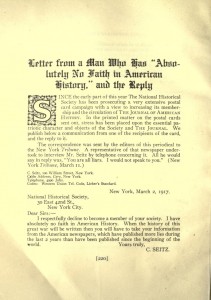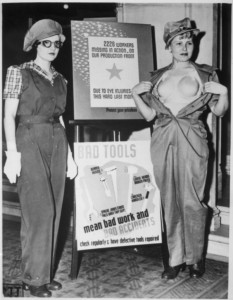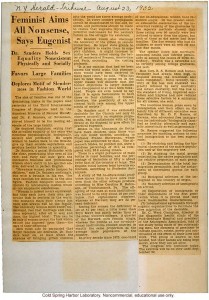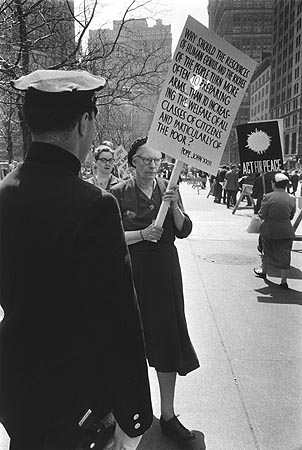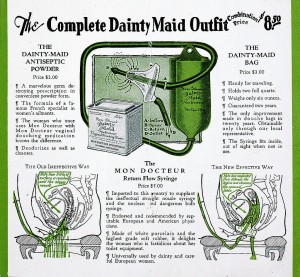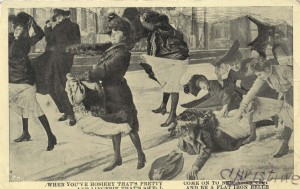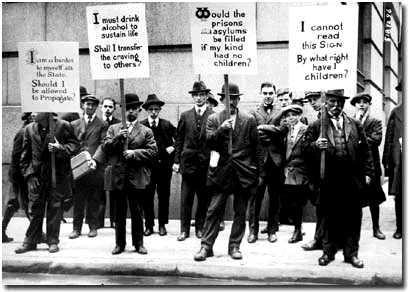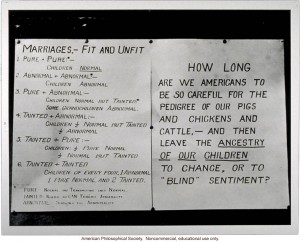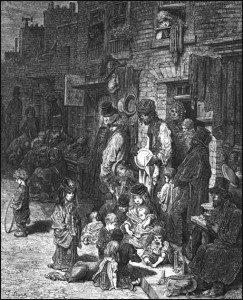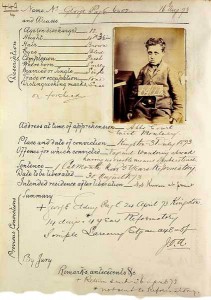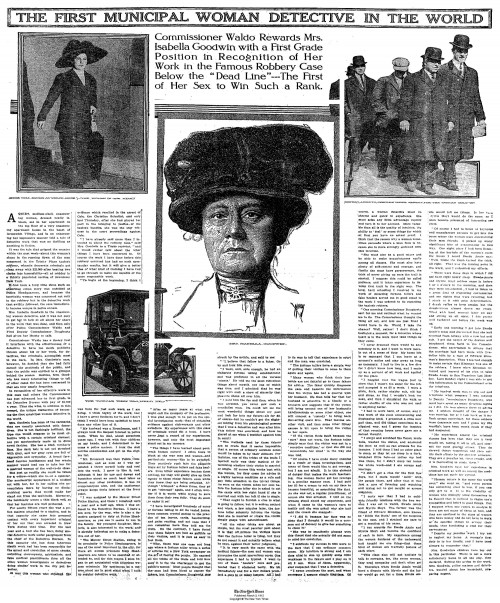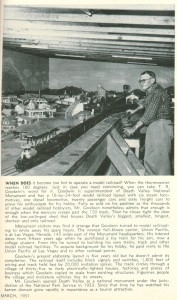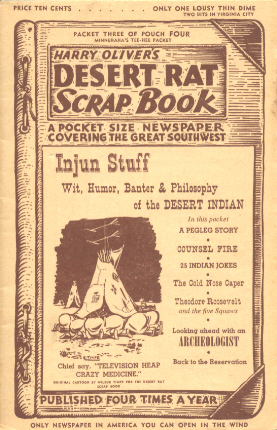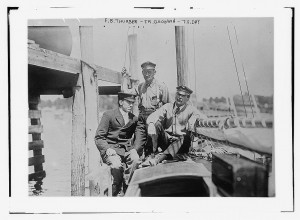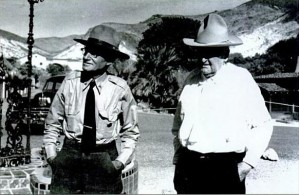Published in the July 31, 1950 issue of Quick magazine, Mrs. Le Roy Nichols of Paterson, N.J., sued her husband for divorce based on “cruelty” — because “he sat her on his lap and kissed her too much, kept her from doing the housework.”
Tag: history
Direct Marketing Crank Response, 1917
An amazing entry I found in The Journal of American History, Volume XI, January-February-March, No. 1, (copyright, 1917, The National Historical Society) which speaks as much to direct marketing responses as it does to attitudes about media. The National Historical Society, seeking to increase membership and circulation of the journal, had been “prosecuting a very extensive postal card campaign.” One of the recipients of the direct marketing response cards sent in a reply:
Dear Sirs:
I respectfully decline to become a member of your society. I have absolutely no faith in American History. When the history of this great war will be written then you will have to take your information from the American newspapers, which have published more lies during the last 2 years than have been published since the beginning of the world. Yours truly,
C. SEITZ.
The journal also notes that the correspondence was sent to the New York Tribune, where a representative of the newspaper tried interview Mr. Seitz by telephone. All Mr. Seitz would say in reply was, “You are all liars. I would not speak to you.”
History Is Ephemeral Carnival, 5th Edition
 Welcome to edition number five of the History Is Ephemeral Carnival, where ephemera & history lovers share & obsess. (If you’ve got posts about old paper, please submit them to this monthly carnival via the carnival’s submission form.)
Welcome to edition number five of the History Is Ephemeral Carnival, where ephemera & history lovers share & obsess. (If you’ve got posts about old paper, please submit them to this monthly carnival via the carnival’s submission form.)
Derek (my hubby) dishes on Hell Bank Notes at Collectors’ Quest.
Monda gives us a little accidental Southern history in Reading the Minutes posted at Fresh Ribbon.
I predict that the next hot ephemera trend will be in ERA collectibles posted at Collectors’ Quest.
The Dean talks about ephemera as local history at Collectors’ Quest.
Frank shows us groovy Grateful Dead holography over at Antiquarian Holographica.
Val Ubell shows us adorable cabinet photos featuring children and vintage photographs featuring ladies’ hats at Collectors’ Quest.
At Things and Other Stuff, Cliff shows off 1936 Godfrey Phillips Stars of the Screen Tobacco Cards — don’t miss the gallery!
At Ephemera, Marty shows us golden age of Hollywood autographs as well as a letter sent to Marilyn Monroe.
My husband also gets an Honorable Mention for his review of David Downie’s new novel Paris City of Night, a story that combines terrorism, auction house fraud, murder, photography (daguerreotypes), and Nazis into a mystery.
And I remind all you collectors and history fans to help museums! Puh-leeeze.
Dating Advice From The Past (Or Female Dating Snark, 1940 Style)
This article, written by an anonymous female, was published in The Bedside Esquire, 1940 — just see how well it holds up today *wink*
The Wench Is Not Amused, by Anonymous
Any girl, if the body she possesses isn’t actually deformed and the face badly moth-bitten, is going to become acquainted with the gentle art of seduction fairly early in life. As for myself, I’ve had what I now recognize as more than my share of experience.
Not at the risk of sounding vain, because I know I am vain, I’ll say that when men look at me in the street I know why. They’ve good reason to. In 1930, when the agency I was working for folded, I posed for several commercial photographers. I’ve seen strange men studying my picture in a magazine and, though their eyes generally started at the ankles & worked up by degrees, I’m pleased to admit that they looked twice at the face, too. And I’ve read a book, I dance well because I love it, I know how to listen as well as talk, I can tell a touchback from a safety, I can hold my likker as well as my men – when I want to – and I know most of the right words. I seldom buy my own dinner.
I know it sounds conceited as the devil but, darn it, it’s true. I’ll lay twenty to one I can make any nine out of ten males, provided they are neither puling infants nor doddering antiquarians, ask for my phone number within any given half-hour.
So, when I say I’ve had more than the average experience with the technique of seduction (horrible phrase) I think I’m stating a simple truth.
When a gal is first turned loose on the world of man the game of seduction – win, lose or draw – is pretty exciting. And it continues to be for some years. At first, either your parents or your school keep you under observation & your only exposed to younger men. Their approach, naturally, isn’t as polished as that which you’ll encounter later. Also, the fact that you are under some sort of surveillance means that you’ll be exposed only occasionally & for brief periods of time & not to the extensive & intensive campaigns you’ll have to face when you become what is so quaintly known as a bachelor girl. During my lat four years of school, a year abroad, & my first three or four years in New York I must admit that I thoroughly enjoyed the whole tiresome process; particularly so when I learned that, so long as I kept my head, the game could be played according to my own rules without ever hurting the boy friend’s sense of masculine superiority in the least.
It was always a thrilling battle & the campaign itself was often more exciting than the storming, or attempted storming of one’s last citadel. How many times I’ve lost in this warfare is entirely a matter of my own business. But I will say this: no campaigner, no matter how hardened, ever overcame my last line of defense unless I deliberately chose that he should – and that can hardly be counted a total defeat.
In the past year, sadly enough, I’ve come to realize that what was once an enthralling game is now a deadly bore. And I contend it’s all the men’s fault. A seduction should be above all things glamorous & exciting. But can there be glamour in a story repeated a dozen, yea a hundred times? Can glamour be expected to survive the hundredth ardent whisper of non-poetic time-worn words? Can there be excitement in a card game played eternally, with both players forever holding the same cards? There cannot!
Why don’t men vary their approaches? Damn it, haven’t they any originality? Must they be so monotonous?
Why is it that each man has at his command three or four of the seven standard approaches to seduction & selects his approach according to what he fondly believes to be his shrewd analysis of the character of the wench he is lusting for?
This is all wrong. And something should be done about it. Why don’t men realize that an injection of originality or novelty into their love-making will get them further with the gal of their temporary choice than any pet phrases or standard passes the gibbering idiots can produce?
Repetition is so damn boring. The fun is all gone if, after the first kiss & the first declaration, you can, from past experience, anticipate practically every word & gesture that is to follow, be it a one night stand or a three week siege. And that isn’t right – sex should be fun.
If you’re a girl who hasn’t given this matter any objective thought, stop now & take stock. You’ll be saddened & disillusioned to see what well-worn ruts your young men pursue.
And you, lad, believing yourself to be a Casanova as you do, cast your eyes over the following catalog – and blush for your sex’s limitations. Blush, too, for yourself, for you have nothing more on the ball than any other man. You’re unoriginal & trite. That swell build-up you were planning to use tonight & which you rather expected to send darling little Jean into a swoon will be the same build-up John used on her two months ago, Paul the week before, Ronald last year, and so on back to the days when she bought her first lipstick & lace panties. And you actually expected her to fall for it tonight? Fooey! Those girlish peals of laughter will probably be at you, rather than with you. But you have only to get yourself a new approach, my lad, really new, and your path will be paved with recumbent maidens.
The following list contains what I’ve found to be the seven fundamental approaches. There are, of course, variants but they are all variants of these basic seven. At least, my own experience & the experience of attractive girls I know leads me to believe that this is a complete list. If it isn’t, I’ve been neglected & I resent that. And if the young man will step forward to present credentials proving that he is in possession of an Approach Number Eight I’ll be glad to meet him on his home grounds, winner take all.
Approach One
The Crudest Simple, and very raw. The idea is for the male to ply you with likker until you lose control. The man who uses this approach is obviously a louse, obviously without resources, and so unsubtle that he is easily seen through & a cinch to out-smart. This technique is so bad it doesn’t merit serious discussion. The only ones who will succumb to this attack are the completely foolish, those who are particularly light-headed drinkers & potential nymphomaniacs.
Approach Two
The Cheapest As crude in its way as One. This man tries to get at you through passionate declarations of love. He may even plead with you to marry him, sometimes soon. Meanwhile, sine you are already man & wife in the eyes of God or, at the very least, two hearts that beat as one – how about it? The man who uses these tactics is probably an even greater louse than the likker-plying-male. The ‘I-love-you’-chanted-soulfully method will succeed only with susceptible virgins (any age) and those stridently emotional wenches of meager intelligence whose metier in life is rocking the cradle. The gal who has been around will merely enjoy her laugh, when approached in this manner, and promptly send the man back to the minor leagues, where he belongs.
Approach Three
The Ham-iest The long-bearded ‘misunderstood husband’ gag. No elucidation is needed. Only fools fall for this chestnut & it is doubtful if, after falling, they deserve any sympathy. It has been my experience that married men are seldom worth the trouble. It is generally wisest to send them home to the little woman, in short order.
Approach Four
The Outright Purchase Like the Greeks, they come bearing gifts; generally expensive & so tendered that it is possible for the semi-prostitute to accept her wages without feeling too professional. The man who pulls this one isn’t fooling. He means business & wants it tacitly understood that there are to be no strings attached to this business deal. And he is intelligent enough to know that the average female is capable of very long distance rationalizing & thus can graciously & righteously accept a fur coat or a diamond ring whereas would regard the offer of actual cash as a terrific insult. This system, probably because it has sound economic & not emotional basis, is liable to work with any of us who haven’t been an heiress. If the man is anywhere near as attractive as his gift it is sometimes necessary for a gal to summon up her last bit of will power to say ‘No.’ But it usually is worth it, if only to preserve those few remaining shreds of self respect.
Approach Five
The Big Brother Act This predatory gent is an insidious operator where the unwary female is concerned. In the first place, he is patient. This, in itself, is usually enough to throw you off. He starts off on a ‘just friends’ basis & worms his way into your heart as a confidant & pal. Before you know it you are, on those odd nights, telling him all about your joys or sorrows with whichever Tom, Dick or Harry you are at the moment involved. He is very sweet, sympathetic & understanding. But he is playing a waiting game. He knows that eventually, human nature being what it is, there’ll be a bust-up between you & the boy of the moment… and when it comes you’ll find his broad shoulder there for you to weep on. You weep & you weep. You’re on the rebound & desperately in need of masculine comforting. And suddenly you find that you’re getting it in a very big, and totally unexpected way. And because you are weak & blue& emotionally drained & in need of some male tenderness you all at once become aware of the fact that your Big Brother is is much sweeter & more desirable than you had ever found him to be before. And if he realizes this at the same time that you awaken… you’re lost. When he puts on the pressure you’re defenceless. I know that this approach depends upon extenuating circumstances but they occur far more frequently than one ever suspects. And a girl on the rebound is in no fit condition to put up an adequate defence. My only solution is this: never trust a man who tries to build up a platonic friendship with you. At the time it may seem to you that it would be such a relief to know a man like that, but you can with impunity bet your last garter-belt that you’re wrong because, some place in the back of his mind, he’ll have an idea or two…
Approach Six
The Pseudo-Sophisticate This approach has three subdivisions but they are all based on the same fundamental sophistry: 6-A. The Philosophical. The life-is-real, life-is-earnest, opportunity-knocks-but-once, so grab-each-fleeting-moment-while-you-may school. This is, of course, the veriest hokum, fit only for children in their teens. Every woman beyond the age of adolescence knows that this unique opportunity the gentleman is so magnanimously offering her is an opportunity that knocks all too damn frequently. Why any man who isn’t completely witless ever thinks a girl will believe him to be the only one who will ever offer her a chance to indulge in a life of sin is beyond me. So, girls, the nest time a man pulls this, ‘Tonight is ours!’ line on you, control your laughter, let him down gently, and send him on his way. The stronger sex? Physically, yes.
6-B. The Pagan. This lad is likely to have long hair. He has read Ulysses and has a glib knowledge of neo-realistic painting or something of that sort. He thinks very highly of individualism & quote Nietzsche’s remarks about the Superman (himself). he tells you that the old, conventional moral standards of our fathers are outmoded (news to you?) and insists that today we see such things as sexual relations with a new vision, a proper perspective. ‘After all, we want each other, and what is going to stop us?’ he asks. ‘Aren’t we free people, free to live our own lives?’ You are also free to point out to him that ‘we want each other’ is taking altogether too much for granted. You explain, in as tactful & gentle terms as the situation requires, that a fairly ardent kiss or two, permitted in a moment of weakness, doesn’t exactly establish the fact that you are willing to turn over the body beautiful. He’ll never believe, of course, that it wasn’t your inhibitions which prevented you from succumbing & he’ll go on his way, still proud of his free & soaring spirit, in search of a girl with low heels & spectacles, who thinks Communism would be nice. And he’ll say to her ‘Look at Russia,’ and get away with it. I don’t want to look at Russia. Blouses & smocks? Not with my torso.
6-C. The Physical. Whereas the first chap in this category went at you on a philosophical plane, so-called & the second tried to weaken you on a moral & individualistic grounds the ‘Physical’ lad goes to the root of the matter & attacks you with body blows. His weapons are psychiatry, Freudian psychology & your glands. These physical realists always have your well being at heart. They explain at great length that sex is an appetite which must be satisfied if one isn’t to become a victim of all sorts of fetishes & suppressed desires. Now, no girl would want to become amorous in public with Shetland pony or become addicted to horsewhipping her grandmother. It isn’t being done. The obvious solution is to permit whichever physical realist is at the moment spouting his propaganda to come between you & the tragedies of perversion. The whole affair is, of course, to be considered in your own best interests.
We may very well be animals & victims of appetites which must be satisfied in order to prevent complexes & frustrations. I’m willing to admit that the boys may have something there. But, so far, I’ve been able to order my own meals & I think I’ll continue to do so. When I’m hungry I’ll eat, if the proper food is available, and no one is going to force improperly prepared food on me when I’m not hungry… and my grandmother will have to take her chances.
Approach Seven
The ‘Forcing’ Method Or perhaps I should call it the cat-and-mouse attack. In any event, the glib gentleman who works this approach on you is primarily concerned with forcing you to make the final move and ‘Safety First’ is obviously his motto. The opening lines generally read something like this, ‘I don’t love you & I know you don’t love me – but I can’t help wanting you. Why pretend? I think you’re swell – sex excluded – but you’re so damned attractive that, no matter how hard I try, when I’m with you I want you.’ Then he adds, oh very frankly & fairly, ‘I like you so much that I have to be honest with you. If I continue to see you I’ll make love to you, I can’t help myself. If you want me to stop coming around, now that you know, you’ve only to say so.’ The catch in this last speech is that he only produces it when he is pretty damn sure that you like him a lot & enjoy being with him. Of course you, liking him as you do & feeling on safe terrain because he hasn’t so much as touched you, laugh it off & take your chances.
But after a night or two of conversation in the same vein but growing progressively more intense, the chances are that he will kiss you: ardently, of course, and probably with considerable finesse – and you’ve given the inch that may coast you your virtue.
Gently & insidiously the campaign progresses. Each night it will become a little more intense & each nigh your defences will fall back and inch or two. But he will never use force, never put on an any obvious pressure. Each time you feel called upon to say ‘Stop,’ he’ll stop – to your growing annoyance. And, though you probably won’t realize it, that is one word you’ll come to use less & less frequently.
Slowly & inevitably the tide, to use a figure of speech, creeps up & up until that night when you’ve forgotten even the meaning of the word – and then the louse stops of his own accord!
The speeches at this point are liable to be on the impassioned side & to deal at some length with his desire for you & your many darling qualities & so on far into the night. Eventually he gets around to asking you if you, too, desire him. After what has just transpired you wonder of he is a complete idiot, then reassure him in your own subtle way.
This generally calls for a clinch & the addition of fuel to the flame. After a proper interval he pulls the Remorse-stop. It goes something like this & is generally delivered in a somewhat throaty voice, ìI want you sooo much (pause) but I can’t let you do this unless you are sure in your own mind. We’re excited now, my dear, (He’s telling you!) and I wouldn’t want you to do anything you’d later regret. I want you more than anyone I’ve ever known, (this is standard: note careful evasion of the word love) but this is too beautiful an adventure to rush into headlong.î While you’re wondering just how he would have you rush into said adventure he makes a suggestion, ‘Sleep on it tonight & think it over in the clear light of day, tomorrow. We’ll meet for dinner, and then you can give me your decision.’
You agree, and this leads to another scene that wouldn’t get by the Will Hays’ office & considerable incoherent & what he thinks is poetic talk about how much he hopes you’ll feel tomorrow night as you do tonight.
Then there is much discussed sleep & ‘thinking (if any) in the light of day.’ It would serve the gent right if the daylight led to a decision he wouldn’t like but for some darned reason it seldom does.
When you meet him the next night he is pretty solemn about the whole thing (but you can be sure he’ll give you the best dinner he can afford, with a rather obvious emphasis on the wine list). Once you get back to whichever apartment is the scene of combat you’ll find that tenderness is the preliminary mood of the evening. He may not use his arms & hands as they were intended to be used as all, but if he does he’ll be very, very gentle. In desperation you finally take him by the hand, figuratively speaking, and lead him to the bedroom.
It may be several days before you begin to realize that you’ve been had in more ways than one. And if this realization doesn’t come to you shortly you are in an even worse position because you’ve been had so thoroughly that your heart may well be in your young man’s hands – and that is one section of your anatomy which should remain permanently yours.
There is a mild variant to this approach. In this method the man, at the critical point, doesn’t suggest a little daylight thought on the subject but, instead, goes dramatic & says, ‘No, this can’t be. The price you pay is too large,’ or words to that effect. It works out in exactly the same way. One says, ‘Perhaps.’ and the other says, ‘no,’ and in the end you are unconsciously forced into taking them both by the hand…
This is probably the most difficult form of seduction to work clear of – because you’ve been allowed to work yourself into it.
These are the standardized versions of sexual Blind Man’s Bluff, Tag, You’re It, or whatever you want to call it, as I know them. There are probably other, depending on race, color or previous condition of servitude but I wager that they are in their way just as standardized. What to do about it?
Sometimes I think I’d rather be attacked. Or at least meet a man direct enough to say bluntly & without preamble, ‘I think you’re swell & I’d like to make love to you. I warn you, if you say no I’ll ask you the same thing tomorrow night. What will it be, milady’s boudoir or the movies?’
The hell of it is, experience has so conditioned me that I’d probably choose the movies & be forced to sit through a Hollywood version of the preliminaries of one of the stereotyped brands of seduction I’ve listed. There’s no escape.
Sign Of The Times: 1943
You’ve heard of safety shoes, right? Well, here’s a safety bra straight out of the history books of home front WWII.
Via The U.S. National Archives at Flickr, the original caption reads: Safety garb for women workers. The uniform at the left, complete with the plastic “bra” on the right, will prevent future occupational accidents among feminine war workers. Los Angeles, California. Acme, ca. 1943.
Just Who Destroys Books & Libraries?
 After reading So Many Books: Reading & Publishing in an Age of Abundance, I was delighted to serendipitously discover a copy of A Universal History of the Destruction of Books: From Ancient Sumer to Modern-day Iraq, by Fernando Baez (translated by Alfred MacAdam), staring me in the face from the “new arrivals” display at the public library.
After reading So Many Books: Reading & Publishing in an Age of Abundance, I was delighted to serendipitously discover a copy of A Universal History of the Destruction of Books: From Ancient Sumer to Modern-day Iraq, by Fernando Baez (translated by Alfred MacAdam), staring me in the face from the “new arrivals” display at the public library.
I’ve always wondered just who would destroy books and libraries — and why. Here was my chance.
The book’s Introduction sums it up best:
It’s common error to attribute the destruction of books to ignorant men unaware of their hatred. After twelve years of study, I’ve concluded that the more cultured a nation or a person is, the more willing each is to eliminate books under the pressure of apocalyptic myths. In general, biblioclasts are well-educated people, cultured, sensitive, perfectionists, painstaking, with unusual intellectual gifts, depressive tendencies, incapable of tolerating criticism, egoists, mythomaniacs, members of the middle or upper classes, with minor traumas in their childhood or youth, with a tendency to belong to institutions that represent constituted power, charismatic, with religious and social hypersensitivity. To all that we would add a tendency to fantasy. In sum, we have to forget the stereotype of the savage book destroyer. Ignorant people are the most innocent.
You could take that at face value — but I preferred to continue reading how Baez came to that conclusion.
In the Note for the English Translation, Baez suggests the following:
I suggest not reading it beginning-to-end because, in its way, this book is an anthology of possible books. The reader, with no remorse, can start reading anywhere. So, dear reader, you are invited to embark on a circular, but, I hope, intellectually stimulating adventure.
Intrigued, I tried to randomly jump around — which is as unlikely as it sounds. Not only an oxymoron & unorthodox, but honestly, after six out-of-order chapters, I found myself desiring the book’s beginning to end layout which (mainly) mirrors a linear progression of time. Not only was this contextually refreshing, but, as a student of US public schools, I enjoy reinforcing what little knowledge of a time line of history I currently possess — & expanding new nuggets of information into such a stately progression was helpful too.
Along with the usual suspects in the destruction of books (natural enemies, such as fire, water, bugs, sunlight, etc.), there’s plenty of discussion, exploration, & historical documentation of those who applied the destruction on purpose. Book burning and book eating may result in the same thing as books on a sunken ship, but these actions usually had very different intents, so Baez covers the many ways to destroy books — accidental & by design. Censorship, on individual & public scales, may seem simple, but Baez exposes the stories behind the persons, passions, politics, prosecutions, and procedures.
Unexpected delights (in terms of chapters or topics — because the whole book is full of both the unexpected, the delightful, and the delightfully unexpected — even the losses are bittersweet for at least I’d heard of them now) included the chapter, Books Destroyed in Fiction.
This book not only affirmed my love of books & libraries, but reminded me how little I know… Including ignorance to relatively current events.
Like while I was very aware of the looting of museums in Iraq (especially after attending MPMA conferences), I never knew about the destruction, looting & losses libraries in Iraq suffered.
And how did I not know there was a fire at the Los Angeles Central Library in 1986 — in my lifetime? Not just any fire, but a deliberately set fire; a fire that must have been fueled with irony for it was both “the single worst library fire to take place in a nation where the most modern mechanisms for the protection of libraries exist,” and a fire started on April 28, 1986, just six days after the international Day of the Book.
Now that A Universal History of the Destruction of Books: From Ancient Sumer to Modern-day Iraq has made me aware of just how ignorant I am, I’ve set Google Alerts for library news.
So Many Books, So Little Time
 “So many books, so little time,” is the common lament of book readers and compulsive book buyers like myself who snap up paperbacks like this discarded library copy for 50 cents. That saying could have been the title of Gabriel Zaid’s book — but then, Zaid’s book covers more than just book readers, so he made the recognizable allusion & added a bit more to the title.
“So many books, so little time,” is the common lament of book readers and compulsive book buyers like myself who snap up paperbacks like this discarded library copy for 50 cents. That saying could have been the title of Gabriel Zaid’s book — but then, Zaid’s book covers more than just book readers, so he made the recognizable allusion & added a bit more to the title.
So Many Books: Reading and Publishing in an Age of Abundance by Gabriel Zaid (translated by Natasha Wimmer), covers the entire family of bookish folk: readers, buyers, collectors, writers, publishers, marketers, & retailers. The distinction of each may not seem like much to you; but having tried my hat at all of the above, I, and Zaid, can tell you there are some large differences (and when the book marketer & retailers, especially, are ignorant, they are very unsuccessful).
Zaid manages to pile on an enormous amount of facts (book publishing has been enriched by the very innovations that seem to threaten it), observations (many authors don’t write for their readers, but to pad their resumes) and philosophies (book are conversations; readers participate in the conversations and, in some cases, arrange the conversations) into a slim, 144 page, book.
But what’s truly amazing is that Wimmer’s translation manages to retain (or perhaps create? I’ve no way of assessing the original Spanish) a concise elegance that is fascinating & impressive.
Especially evident (as well as powerfully provocative) in chapter six, when the author lays out, step by step, how “learning to read is the integration of units of ever-more-complex meaning.” Ab-so-feakin’-lute-ly mind blowing to consider — while you are literally doing it!
Just how my copy of this book was deemed an unnecessary conversation by a library (the Lake Agassiz Regional Library, Moorhead, MN — not my Fargo Public Library!) seems more than ironic, but sad. Because I haven’t hugged a book to my chest like this in a long long time.
A true feast for bibliophiles craving both the intellectual & the literary, I could quote nearly endlessly from So Many Books — or at least 144 mass market pages worth. *wink* But out of respect for the author & translator, I’ll limit myself. These are my favorite passages — the juiciest ones that really make me think about myself — which come from the second chapter, titled An Embarrassment of Books:
Those who aspire to the status of cultured individuals visit bookstores with trepidation, overwhelmed by the immensity of all they have not read. They buy something that they’ve been told is good, make an unsuccessful attempt to read it, and when they have accumulated half a dozen unread books, feel so bad that they are afraid to buy more.
In contrast, the truly cultured are capable of owning thousands of unread books without losing their composure of their desire for more.
“Every private library is a reading plan,” Spanish philosopher Jose Gaos once wrote. So accurate is this observation that in order for it also to be ironic the reader must acknowledge a kind of general unspoken assumption: a book not read is a project uncompleted. Having unread books on display is like writing checks when you have no money in the bank — a way of deceiving your guests.
If that doesn’t make you smile — or at least grudgingly nod to yourself — then you book collectors will hate this next one:
A terrible solution is to keep books until you’ve accumulated a library of thousands of volumes, all the while telling yourself that you know you don’t have the time to read them but that you’ll be able to leave them to your children. This is an excuse that grows weaker and weaker as science makes even greater strides. Almost all books are obsolete from the moment they’re written, if not before. And marketing strategies engineer the planned obsolescence even of classic authors (with new and better critical editions) to eliminate the ruinous transmission of tastes from one generation to the next, which once upon a time.
The creation of an obsolete library for one’s children may only be justified in the way that the preservation of ruins is justified: in the name of archaeology.
Perhaps it at this point (page 16) that those who checked out So Many Books angrily stopped reading, returned the book to the library, and continued Zaid’s conversation in the most unflattering of ways, bad-mouthing the book into that useless space-taking-with-no-check-outs status that forced the librarian to discard it.
But me? I saw myself in those passages — and I loved it. Sure, it’s like those extra pounds I’ve got; not so pretty too look at for some, but baby, that’s all me! Before I can decide what — if anything — I should do about it, I have to first be aware of it. So Zaid held up a mirror and now I get to think about it… Why do I do that? (I buy it cheap, so that it’s at my fingertips — and there’s that osmosis thing.) Is he right? (I most vehemently do not agree all books become obsolete — some conversations ought never die & the past should be included in those conversations.) And then I get to converse with others about it. Awesome!
In case those passages really hurt your feeling (or before you rush off and buy yourself a copy of So Many Books), I’ll leave you with the following passage from the end of chapter one, To the Unrepentant Reader, which may put you & I & Zaid & all readers each in a better light:
The uniqueness of each reader, reflected in the particular nature of his personal library (his intellectual genome), flourishes in diversity. And the conversation continues, between the excesses of graphomania and the excesses of commerce, between the sprawl of chaos and the concentration of the market.
Topless Women Circle Skirt
This vintage circle skirt with a Hawaiian tropics pattern featuring topless women amuses me.
This also serves are a reminder for you to check out Here’s Looking Like You, Kid‘s circle skirt history lessons — especially the expose on why the poodle skirt was the first “too young for you” fashion. Here’s my favorite quote:
The poodle skirt craze among teens is often attributed to those new rock n roll dances; teens found the big circle skirts enchanting while dancing. But it’s quite probable that mom & dad preferred their Kitten to wear a longer full skirt that hid at least part of her figure (especially when stuffed with crinolines and petticoats to prevent anything more being seen) to the more fitted along the hips structured fashions; watch Kitten’s skirt swing, not her hips sway. *wink*
(Of course, the irony was that fuller skirts looked like fuller, more womanly, hips and that boys dreamed of ladies’ underthings, so…)
But let’s not overlook the marketing machine in all of this either…
Museums Need Your Help!
Did you know that the Institute of Museum and Library Services (IMLS) provided $210.5 million to libraries in 2006, while museums received only $36.5 million? Why the difference? Federal formula grants given from IMLS directly to the states accounted for $163.7 million of IMLS’ library authorization.
As a member of the Mountain-Plains Museums Association (MPMA), I was shocked to discover this through my most recent member newsletter. Hey, I’m all in favor of the libraries getting money — but I want museums to get funds too.
August is recess time for elected officials — and that means it’s a great time for you to contact your members of Congress to tell them to support comprehensive reauthorization of IMLS for museums; remaining silent is to communicate complacency.
What we — you & I — have to do is persuade Congress about a new appropriation for museums. We need to convince our Congressional leaders to support a new grant program for museums when IMLS is reauthorized (which could happen as early as this fall). The new grant program, called Federal-State Partnership Grants, would allow IMLS to provide grants to each state which would then distribute funds based on needs determined by individual states.
But museums can’t get these funds until Congress has included the Federal-State Partnership Grants in IMLS’ reauthorization. That’s why it’s important that you tell your Congressional leaders to support IMLS reauthorization and the Federal-State Partnership Grants.
If you ‘get it’ and agree, all you have to do is go here, fill out your information, and then click either “edit/print your letters” or “edit/send email” (editing is optional). Simple! And needed.
If you’re still confused, then keep reading…
I know this post is long; I wish I could just link to all this information, but, possibly because they are grossly under-funded, museums are sorely lacking in text web pages (opting, instead, for PDFs & files most people are too lazy to open & read). So, doing my bit for museums across the USA… Here’s what museums want:
Reauthorization Congress reauthorizes the Office of Museum Services (OMS) at the Institute for Museum and Library Services (IMLS) every five years. The Federal-State Partnerships Coalition supports an incremental increase in OMS reauthorization to the level of $95 million (from current $38.6 million) over the next 5-year reauthorization period, scheduled to begin FY 2010. The Office of Museum Services at IMLS is the primary source of federal support for America’s 18,000 museums. With nearly flat growth at OMS over time, attendance has increased and museum services to school and communities are needed and wanted more than ever. The Federal-State Partnerships Coalition supports growth at IMLS through:
- Strengthen Existing National Program to provide a significant increase (minimum of $45 million) for existing programs that have been insufficiently funded for years.
- State Needs Assessments—Once appropriations exceed $45 million, up to $2 million per year appropriated for states to conduct needs assessments with museums. The needs assessments are an important first step toward establishing a federal-state partnership program through federal formula grants to the states.
- Conservation, Traveling Exhibits, and Helping Smaller Museums as appropriations rise above $47 million to $72 million, establishing new grants for conservation and traveling exhibitions, as well as programs that will make it easier for small museums to compete in the national grant pool at IMLS.
- Federal-State Partnership Grants to States, a federal-state partnership to be appropriated once OMS exceeds $72 million. The IMLS Director would have discretion to provide up to $20 million of any annual appropriation in excess of the $72 million mentioned above. Once appropriations reach $92 million, the IMLS Director would have discretion to provide up to 50% of all excess funds toward the federal-state partnership.
Appropriations for FY 2010 – The Federal-State Partnerships Coalition supports the Office of Museum Services at IMLS at the level of $50 million for FY 2010 – a $15 million increase over FY09 and provided through the Labor-HHS-Education appropriations bill.
For more information, see the American Association for State and Local History (AASLH); the AASLH serves as the Coalition Administrator for a network of state, regional, and national organizations — the Federal-State Partnerships Coalition.
Now, send those letters!
For more on this issue, see also:
Representatives Paul Tonko (NY-21) and Louise Slaughter (NY-28) circulated a “Dear Colleague” letter on this issue, prompting Whoa! A Letter Reveals The Need to Cultivate Congress at ArtsJournal.com.
The IMLS’ Connecting to Collections developed a video to underscore the importance of collections held in museums, libraries and archives throughout the U.S., and to inspire communities to take action.
Have You Been… To The Smithsonian?
The Smithsonian Institution was founded on this date (August 10th) in 1846. Named for British scientist James Smithson, who willed his fortune to the U.S. to establish the institution, today the Smithsonian is made up of 19 museums (including the National Air and Space Museum — the most visited museum in the U.S.), the National Zoo, and nine research centers. The Smithsonian houses more than 136 million items in its collections, earning it the nickname of “the nation’s attic.”
Feminist Aims All Nonsense, Says Eugenist (1932)
Via Eugenics Archive, a clipping from the New York Herald dated August 23, 1932 — a review of Third Eugenics Congress:
If you don’t have time to read the whole thing, here’s a snippet that might change your mind:
Feminist Aims All Nonsense, Says Eugenist
—
Dr. Sanders Holds Sex Equality Nonexistent Physically and Socially
—
Favors Large Families
—
Deplores Motif of Slenderness in Fashion World
—The size of families was one of the dominating topics in the papers read yesterday at the Third International Congress of Eugenics held in the American Museum of Natural History, and Dr. J. Sanders, of Rotterdam, proved himself to be the leading advocate of the large family.
He deplored feminism, saying that the so-called equality of the sexes was nonsense physiologically, biologically, socially and politically. He urged women hasten back to the fireside, give up their outside aspirations and produce healthy babies in quantity.
Dr. Sanders, a genial Hollander with the clear, penetrating blue eyes of his race, and curly fair hair, gave the successful business and professional women short shrift in his spirited address, delivered in perfect English.
“Nowadays women prefer fashion to children,” said Dr. Sanders scathingly, but with a twinkle in his eye, “for large families are inimical to the slim figure. Fashion designers should cooperate by introducing models which do not emphasize slenderness.
“Woman is indeed man’s equivalent, but they each have their own particular task to perform in the world. The woman’s main duty always has been and always will be the family. The university woman must know, understand, feel that marriage and children represent, after all is said and done, the highest ideal. This can be so only if women accept the task which nature has imposed upon them — the care of their offspring.”
Sign Of The Times: 1959
Vivian Cherry photograph of Dorothy Day, founder of the Catholic Worker newspaper, picketing against the Atomic Bomb, New York, 1959.
Signs Of The Times: 1968
Photograph by Steve Schapiro, New York, 1968.
As an ephemera collector, I can’t help but wonder… What ever happened to that sign?
History Is Ephemeral, 4th Edition
 Welcome to edition number four of the History Is Ephemeral Carnival, where ephemera & history lovers share & obsess. (If you’ve got old paper & their stories to share, please submit your post to this monthly carnival via the carnival’s submission form.)
Welcome to edition number four of the History Is Ephemeral Carnival, where ephemera & history lovers share & obsess. (If you’ve got old paper & their stories to share, please submit your post to this monthly carnival via the carnival’s submission form.)
Nava presents I Dreamed . . . posted at A Long Way, Maybe.
Cliff Aliperti presents Free France – A Fortnightly Bulletin Published in NY During WWII and Let’s Set the Record Straight! Motion Picture Magazine slams Photoplay! — both posted at VintageMeld.com.
Rick Sincere presents Smoke Gets in Your Eyes posted at Rick Sincere News and Thoughts.
Val Ubell presents Unique Militaria: WWI Sheet Music and Discovering Fabulous Artwork: Collecting Edward Gorey Books — both posted at Collectors’ Quest.
Marty presents My Apology to Eugene Levy (or My Drink with John Candy) posted at Ephemera.
Lauren presents Bookmark Babies posted at BiblioBuffet (found via bookmark-collector.com).
Cliff Aliperti presents 1920s T83 Movie Stars – Schinasi Brothers Egyptian Prettiest Tobacco Cards posted at things-and-other-stuff.com.
Here at Kitsch Slapped, I present Things I Want In My Hubbard Cupboard and Ephemera Really Blows My Skirt Up (and a few other less investigative, but cute, ephemera posts).
And when I interviewed Frank DeFreitas about his holgraphy ephemera, I told him I’d mention his new ephemera podcasts here too — if you’re interested in ephemera, check it out!
That’s it for this edition! If you found some interesting ephemera, please, submit your blog post/article — or one you like — to the next edition of history is ephemeral using the carnival submission form. (Past posts and future hosts can be found on the blog carnival index page; if you’d like to host an edition of the carnival, just let me know!)
Did Margaret Sanger Sell Dainty Maid Outfits?
First my disclaimer: I sadly do not own this old advertisement & instructions for the “Dainty Maid Outfit” (douche bag, antiseptic powder, and syringe); I found it while searching at the Library of Congress for photos of Margaret Sanger for the eugenics post.
The reason I didn’t include it then & want to discuss it now is two-fold.
One, there’s some confusion over Sanger’s connection to the item.
While the LoC notes that this paper, published between 1900 and 1930, was part of Sanger’s collection, saying, “Like many of her contemporaries, she retained all kinds of printed matter accumulated during her career, including pamphlets like this one relating to women’s gynecological health and hygiene,” it’s not entirely clear that this is the end of the antique ephemera’s story.
In 2006, the Margaret Sanger Papers Project (MSPP) reported this (links added by moi):
In his recent book, Men of Tomorrow: Geeks, Gangsters, and the Birth of the Comic Book (New York, 2004), author Gerard Jones highlights the role played by the poet and editor Harold Hersey in the pulp publishing industry. Hersey, one of Sanger’s lovers in the late 1910s, later wrote an unpublished biography of Sanger. He worked closely with Sanger in the early days of the Birth Control Review. “We didn’t only sell magazines,” Jones quotes Hersey as saying, “but also razor blades and other items.” “The ‘other items’,” Jones explains, “were contraceptives. Sanger was not only a proponent of birth control but a mail-order dealer, with her own line of condoms, diaphragms, and ‘Dainty Maid’ douche kits.” That is new information to us. Sanger was always extremely careful never to associate with the commercial trade of contraceptives. Her opponents often accused her of profiting from her cause, but there has never been a shred of evidence she received money for selling birth control or taking part in a mail order business – under or above ground. It is possible that one distributor of the Review, Eastern News, used its sales network to send illegal publications, condoms and liquor around the country, but most likely Sanger had no knowledge of it. For his sources, Jones cites Hersey’s autobiography, Pulpwood Editor, which does not mention the mail order venture, and unspecified collected material by Michael Feldman, a researcher on the comic book business. Thanks to Professor Ed Shannon for bringing this one to our attention.
However, there was a 2007 release The New Pulpwood Editor also. And, despite claims to Hersey’s “unpublished biography” of Sanger, others claim to have a copy. All of which not only further confuses things in terms of what source was used, but leaves the accuracy of Hersey too far down the pecking list at this point to even verify it.
But regardless of the characters involved & their individual characters regarding telling tales (& proper documentation of sources), how can the MSPP claim Sanger’s ignorance to The Dainty Maid Outfit when the LoC has it — and in their Margaret Sanger collection (Papers of Margaret Sanger, container 252) yet?
The second reason I brought this vintage female hygiene ad up separately should be apparent: researching is not for the timid, not the easily exhausted.
If this was a product Sanger offered via mail order, then perhaps The Dainty Maid was more than a cleansing douche… Contraceptive products, illegal at the time, were sometimes sold with the word “French” used as a secret code to communicate the “illicit” purposes of the product; either to wash away sperm post-coitus or perhaps even the “antiseptic powder” was even a spermicide.
Ephemera Really Blows My Skirt Up
When I snatched-up this antique postcard, I was so seduced by its charms that I thought I had something few had ever seen since the 1900’s; but, as it turns out, you can find scans & images of this old postcard a few places online.
But what makes my posting of it unique and interesting is that, unlike my compatriots who’ve shared the image, I am so smitten with ephemera that I must unlock its secrets & share those too…
The text reads:
When you’ve hosiery that’s pretty
And lingerie that’s swell
Come on to New York City Christine
And be a Flat Iron Belle
Now the crossing-out of New York City & replacing it with Christine (a small city in North Dakota) has been done by hand — but it is not inviting someone to a woman named Christine. *wink* It was done by the hand of what looks like an A.N. Gunderson who was cheeky enough to tailor the postcard into an August 22, 1909, invitation for (presumably) his friend, Alfrid Olson, to come visit him in Christine.
That historical personalization is cute; but I just kept wondering what the heck a “Flat Iron Belle” was.
Based on the rhyming text description and the “semi-photo” visual of ladies’ underthings, I just knew this card was special… But other than the afore mentioned images, searches for “Flat Iron Belle” didn’t turn anything up. So I turned to the real world and did some research.
I turned to my husband and asked, “Do you know what a ‘flat iron belle’ is or was?”
He, the all-knowing, all-seeing Wizard of Odd, informed me that there was a Flatiron building. (It is so useful, when stuck, to utter a question and have your intelligent walking encyclopedia of a mate tell you not just ‘stuff,’ but the right stuff so you can continue your obsessive researching.)
From there, a hop skip & jump (over Wikipedia, which I mistrust intensely) to Columbia University’s The Architecture and Development of New York City with Andrew S. Dolkart & his entry on The Flatiron Building, “The first building to become a romantic symbol of New York.” Dolkart says:
[I]t was a symbol because of its triangular shape. Thus the name Flatiron, because it looked like the old irons that people used to iron clothing. It was originally called the Fuller Building because it was built by the Fuller Construction Company for its headquarters, but people almost immediately called it the Flatiron Building. The Fuller company understood the value of this name and popularity of the building, so they began calling it the Flatiron Building as well, and that became the name by which everybody knew this building.
OK, so now you understand the name — even if on the postcard it says “Flat Iron” rather than “Flatiron.” But what of the windswept skirts?
It was not only a building that appealed to high-art interests, such as people who were interested in Steichen’s photography or Hassam’s paintings, but this building also entered popular culture. It is at a triangular site where Broadway and Fifth Avenue—the two most important streets of New York—meet at Madison Square, and because of the juxtaposition of the streets and the park across the street, there was a wind-tunnel effect here. In the early twentieth century, men would hang out on the corner here on Twenty-third Street and watch the wind blowing women’s dresses up so that they could catch a little bit of ankle. This entered into popular culture and there are hundreds of postcards and illustrations of women with their dresses blowing up in front of the Flatiron Building. And it supposedly is where the slang expression “23 skidoo” comes from because the police would come and give the voyeurs the 23 skidoo to tell them to get out of the area.
So there you have it; “Flat Iron Belles” were the beauties looked at (or those who became beautiful by virtue of winds making a disarray of their virtuous skirts). And there, supposedly, is the reason for the phrase “twenty-three skidoo” too.
The questionable innocence of peeping Toms aside, I am at least comforted by the fact that the sole male in the scene is not one of those (hopefully) assisting the fallen wind-swept women. Those hands look more like they are stroking the fine underthings than reaching to help the fallen; so even if the problem is an unrefined artistic skill, at least I don’t have the nightmare of male (physical) assault.
Collectors, the information you seek to find this coveted card & add it to your collection is scant; you’re best bet is to search online for the lingerie verse, because the card has no markings save for number 78 on the front lower left hand corner and [K] Semi-photo on the back (like this one).
If You’re Forced To Have A Baby, Don’t Throw It Out With The Bathwater (Or, Of Margaret Sanger & Eugenics)
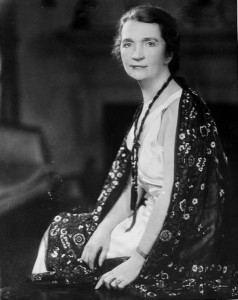 In Margaret Sanger in Context, Tracey McCormick defends the vilified Margaret Sanger. Sanger, who founded Planned Parenthood and advocated for planned parenting & birth control before women even had the right to vote, is often misquoted or quoted out of context.
In Margaret Sanger in Context, Tracey McCormick defends the vilified Margaret Sanger. Sanger, who founded Planned Parenthood and advocated for planned parenting & birth control before women even had the right to vote, is often misquoted or quoted out of context.
McCormick takes up defense of Sanger against New Jersey Congressman Christopher Smith’s quoting of Sanger from Sanger’s book, Woman and the New Race (1920): “The most merciful things a family does for one of its infant members is to kill it.”
This is McCormick’s response:
The line in question comes from Chapter 5, “The Wickedness of Creating Large Families.” Upon closer inspection, we see that Congressman Smith has left out the word “large” before family.
…But what if we read the entire paragraph or even the whole chapter?
…Apparently she hated miner families. Excessive childbirth in these families caused ill health in mothers, financial hardship to fathers, and I’ll quote directly for its effect on the children: “In the United States, some 300,000 children under one year of age die each twelve months. Approximately ninety per cent of these deaths are directly or indirectly due to malnutrition, to other diseased conditions resulting from poverty, or to excessive childbearing by the mother.
To demonstrate her hate, Sanger provides us mortality statistics of miner children, quotes a study by Arthur Geissler, which was later cited by Dr. Alfred Ploetz before the First International Eugenic Congress. (Eugenics is a scary word; if we took it out of context we’d realize that that’s what Hitler was up to. And if we practiced some really sloppy thinking, we’d say Sanger = Hitler. But we’re much smarter than that.)
To return to the statistics of children surviving through their first year. The first five children of these large miner families had about a 75% survival rate. The sixth-, seventh- and eighth-born approach a 70% survival rate. The eighth and ninth, about a 65% chance. The tenth, 60%; the eleventh, 50%; and the twelfth, 40%.
Five sentences later, Sanger drops her bomb: “The most merciful thing that the large family does to one of its infant members is to kill it.”
I didn’t know the woman personally, but I don’t think Sanger was a proponent of infanticide: I think she was trying to say and do something about the infant mortality rate. But you shouldn’t believe me. This is, after all, nothing more than a 750-word soundbite.
For context, you can read the entire chapter here.
For more-more context, the entire book, Woman and the New Race, is available here.
If you have four hours to spare, you can watch the entire hearing, “New Beginnings: Foreign Policy Priorities in the Obama Administration,” here. (Thanks, C-Span!)
Then, you’ll have context of Sanger and her relationship to “New Beginnings.
I applaud McCormick for taking up the fight here — both in terms of Sanger specifically and the issue of context in general. But one thing is missing from this conversation: The subject of eugenics itself.
The word “eugenics” has become an ugly thing, and rightfully so; but it too has its own context which must be understood. Understanding the context & origins of eugenics is key not only to understanding Sanger (and others), but its lessons are the epitome of the cornerstone of studying history: So that we do not repeat it.
Eugenics should not be simply or only equated with racism or even a scientific excuse for racism; that fine institution, racism, had already been in long practice. Eugenics has been around since the dawn of man; ancient societies, of all races, practiced infanticide for such purposes and Plato advocated that human reproduction should be monitored and controlled by the state. At the root of eugenics is a drive to improve human genetic qualities, better sustain the species, which includes everything from prenatal care for mothers to euthanasia.
But, yeah; racism sure was a part of eugenics for many.
American eugenics, as we speak of it here (referring to movements and social policies), was born in a post Civil War world where rapid growth of industrialization (including the increased mechanization of agriculture) created the first major migration away from farms, including former slaves. At the dawn of the Industrial Revolution there were a plethora of problems from such rapid urban growth. Cities were unable to keep up with the increasing populations; the exploitation of labor created militant labor organizations; swings in prices bankrupted many businesses — all of this led, in 1873, to a series of depressions which occurred roughly every decade through the early 1900s.
The depressions further fueled labor & over population issues, which were then additionally burdened by huge waves of immigrants (especially from southern and eastern Europe), which peaked just before World War I (and again after the war too). Then, as today, many Americans began to resent immigrants “stealing” their jobs, their housing, and even their spots in charity programs.
At first, “the poor” and the social & economic problems were, philosophically and physically (via social work, charity organizations, churches, etc.), addressed by Social Darwinism, the application (if not perversion) of Charles Darwin’s biological theory. While Darwin himself did not extend his theories to either social or economic levels, many educated people believed that “survival of the fittest” applied to (and therefore could be used to explain as well as manipulate) social and economic inequalities. But the irony was that the wealthy & powerful, “the fittest,” were endangered. Not only were the working class and the poverty stricken organizing themselves against the wealthy, but a declining birthrate among the captains of industry meant that the lower classes were out-reproducing them too.
Enter progressivism.
Progressive reformers believe(d) in the increased role of government to manage & plan for economic and social issues. Beneath working for the passage of legislation advancing the rights of the newly freed slaves; the establishment of labor unions, child-labor protections, & minimum wage laws; conservation of natural resources; direct elections in primaries, fairer taxation, & control of lobbyists; legislation to control monopolies, banking reform, & trust-busting; and working for women’s suffrage, lay science. (And a managerial class of educated experts capable of long-range planning.)
It didn’t take much for progressive reformers to convert inventive Americans to a strong faith in science as the way to address the problems plaguing the country. This opened the door, using the new science of genetics to spawn an even newer science of social engineering — eugenics. If genetics held the key to such things as alcoholism, criminality, “feeble-mindedness,” and poverty, eugenicists argued, society, who paid a high price caring for such individuals and their issues, should invest in the knowledge & planning to ensure a better genetic America.
Some went as far as to say that sterilization of one “defective” adult could save society thousands of dollars over future generations. So when researchers became interested in the heritability of such illnesses as schizophrenia, bipolar disorder, and depression, the findings of their studies were used by the eugenics movement as proof of its legitimacy, prompting state laws prohibiting marriages for and forced sterilization of the mentally ill in order to prevent the “passing on” of mental illness to the next generation. (These laws were upheld by the U.S. Supreme Court as recently as 1927 and were not abolished until the mid-20th century.)
Now remember the afore mentioned context; not only were social & economic issues a matter of The Haves & The Have Nots, but great tension arose from the fears of going from the former to the latter. The power of labor unions & the rise of the American socialist party combined with world events such as the successful Bolshevik Revolution, increased these fears, inspiring the wealthy to support eugenics. As today, funding for research & media meant that the wealthy could steer, if not actually dictate, the work of eugenicists. The repugnance for class struggles and political radicalism certainly figured into eugenics, resulting in selective immigration restriction.
In short, eugenics put such a focus on defective genes, individuals, and ethnic groups that it removed the focus from all the problems of the structure of American society itself. And the copious amounts of “scientific evidence” for eugenics being the rational and efficient plan for a harmonious future allowed the wealthiest in society to feel justified in blaming & controlling the victims.
I won’t go so far as to say that Margret Sanger was only philosophically identified with eugenics from the point of view of individual families using birth control to combat their economic & societal problems; there’s too much evidence that Sanger was into eugenics far deeper (& dirtier) than that. (While her work with The Negro Project & her acceptance of invitations to speak to women in the KKK remain controversial, there’s no arguing that Sanger was an eugenicist, including a proponent of using immigration laws to keep out those with “objectionable traits”.) I’m not even saying we should forgive & forget Sanger’s association eugenics because it gave us birth control. I’m saying we have to look at the context of the times — societal issues & individual concerns, education & prevailing science, fears & beliefs. And it’s clear that for a century, from the mid-1800’s through the mid-1900’s, eugenics was a huge part of the culture. So I think we should if not forgive, then at least not entirely condemn; but we certainly should not forget — not to be kind, but to see… To not dismiss. As Garland E. Allen wrote:
The problem with demonizing the older American eugenicists (many of whom thought they were taking the most modern, scientific and progressive approach to social problems) is that we distance ourselves from them and so can easily fall prey to our own biases today.
Margaret Sanger was not perfect. But looking at her life & work in context we are able to admire what is valid and also learn to accept the warnings we must heed about what is not valid.
Why We Vilify Single Moms
When I was in college I was a single parent. Finding myself struggling personally with the demands of continuing education and single parenting (a special needs child too yet) was challenging enough; but this was at the time that Tommy Thompson was governor & he made bashing single moms & welfare a public sport. (Yeah, some of us fought back; like the Welfare Warriors.)
It was incomprehensible how those of us left with children were not only held accountable while biological dads walked away Scott-free, but were to blame for all of society’s ills. Even those who raised children alone by design & without public assistance were vilified, a la Murphy Brown. It wasn’t just moral outrage (though that did & does exist); it wasn’t an ignorance — these were educated people saddling us with unrealistic responsibilities and ludicrous outcomes. We were being scapegoated with such an intensity that it must be hiding a deep fear of some sort… Was it simply another way to display the classic fear & hatred of “female,” or was there more?
It got me thinking: Certainly being a single parent had never been easy, but had it ever been easier? At least from a societal point of view?
A classmate & friend, another single mother herself (shout-out to Vicki Davidson, if she can hear me!), decided to investigate. What we found would later be presented at one of those extra-curricular brown-nosing events (in the history department, which didn’t help with any of our majors; but we did, I will say, impress the department staff with work that, I quote, “was at or above masters work”).
What we discovered, was that the vilification of women having (&/or raising) babies out of wedlock dated back to Victorian times. This may not surprise many who would attach such times to the origins of our currently held morality — but it wasn’t (at least entirely) Queen Victoria’s morality that had done the deed & made single mothers dirty; it was mainly a byproduct of the Industrial Revolution.
Before the Industrial Revolution, children had great value in farming; any additional mouths you have to feed come with additional, literal, farm hands. Mom, dad, older siblings still did their work as they watched the littler ones; little ones automatically observed the work and therefore received on-the-job training under the auspices of childcare. Large families meant there was no need to hire help — and mom & dad were assured someone would be there to care for them as they aged.
This, more than church-hurled slurs about paganism, is the more practical reason why when Mr. or Mrs. Farmer wandered down to the next farm for a roll in the hay, no one worried about an illegitimate child. Why fuss about Mrs. Farmer being knocked up by a neighboring farmer when it’s just more farm hands? Especially when you spotted proof of your own afternoon delight working at a neighbor’s farm. (It was not uncommon for casual acknowledgment of such situations; no rows ensued, unless someone wanted those little hands for their own farms. And it begs for some research regarding jokes about the farmer’s daughters.)
But the rapid growth of industry, including the increased mechanization of agriculture, created the first major migration away from farms to cities and changed everything.
Among the many problems with such rapid urbanization comes the devaluation of children. Children are not only less desirable industrial workers (especially after childhood labor reform acts), but they also become an economic drain; more mouths to feed, but no automatic work hands.
From 1861 through 1885, several Acts were instituted which significantly affected the working-class mother. The first of these Acts was the 1861 Offences Against the Person Act. According to Carol Smart, in her essay “Disruptive Bodies and Unruly Sex: The Regulation of Reproduction and Sexuality in the Nineteenth Century,” this was established to deal with “rape, procuring, carnal knowledge, abortion, concealment of birth and exposing children to danger” (13). Throughout the nineteenth century, incidents of infanticide were continually on the rise, in large part because little was done to convict the guilty party. Violent acts by desperate working-class women resulted in a movement to put more emphasis on holding someone, namely the mother, responsible for these deaths came to a head with the passing of the 1861 Offences Against the Person Act. As working-class women oftentimes found themselves financially challenged, they would accordingly find themselves financially unable to support their children (Smart 17). Women who gave birth to illegitimate children found themselves in a particularly questionable situation. On the one hand, if a woman kept the baby, she would likely be unable to properly provide for it; however, if she concealed her pregnancy and abandoned the child, she would be held liable, with the potential of being sentenced to hang, regardless of whether the baby was born alive or dead (Smart 16). Women who had children out of wedlock, who were unable to financially support their children had to face the difficult decision whether to keep the child or turn the infant over to another’s care, thus avoiding the repercussions of being found guilty of infanticide.
But what of the children?
Those visions you may have of beautiful Victorian cherub-children, the history which boasts of Victorian times “finally” bringing about children’s toys & a time “when children could finally be children,” these are not representative of most children. The average child in Victorian times was trapped the poverty, grime & disease of the Industrial Revolution — just as their parents were. The juxtaposition of the images isn’t graphic fantasy; there were two worlds. (Just as there were two worlds in terms of Victorian morals & sexuality; but that is for another time.)
The wealthy children may have found themselves clean, well dressed & with plenty of playtime on their hands, but most rural children spend their time hungry & packed in one room with 3-9 siblings & their parents or working as hard as their parents to ensure the family’s survival. And those were the lucky ones. Some went to prison — yes, children went to prison for their crimes, and some were even hung for them.
Disease & injury at work, along with other conditions of urban poverty, did leave some children orphaned; and with no family nearby, or none willing & able to take them in, there became the street urchins of Oliver Twist tales. However, orphans were not the only urchins running the streets.
 Along with orphans, there were abandoned children & children of the homeless living on the streets. The streets were littered with trash & children (including some children who were there just trying to help their families eek out a living). These children were often called “street Arabs,” an ethnic slur for nomadic activities that weren’t understood.
Along with orphans, there were abandoned children & children of the homeless living on the streets. The streets were littered with trash & children (including some children who were there just trying to help their families eek out a living). These children were often called “street Arabs,” an ethnic slur for nomadic activities that weren’t understood.
To care for the orphaned & stray children, the Victorians built many large orphanages (along with lunatic asylums and infirmaries to house, if not care for, those unable to work, and workhouses).
Once built, orphanages housed more then orphaned & abandoned children. Poor mothers and fathers negotiated with institutions to place their children there temporarily, for assistance to overcome short-term family and economic crises. These children were called the “ins and outs” or “casual children” because of there frequent short stays at institutions.
As you can imagine, what with all the popular “fallen woman” & prostitution stories from this time, a large number of casual children came from single parent households. Not all single parents were unwed or even single mothers. Some single parent situations were created by deaths, of course, but it was also not that uncommon for one parent to be institutionalized, put in a dreaded workhouse, or in prison; leaving the other parent to fend for themselves and the children alone. But single mothers were among the majority of those who used the orphanages as temporary shelter for their children or abandoned them there entirely. Some even used the institutions as a sort of childcare; placing their children there while they went to work as live-in maids etc., visiting the children on days off.
Whether these buildings were public works or run by private charities, at some point people began to stand up and ask themselves, “Why am I paying to support someone else’s child?”
Great pains were taken to interrogate mothers & the children themselves to ascertain the name of the father, so that he could be held accountable. This meant financially responsible — but not in payments or support of any kind to the child or the mother herself; no, responsibility was only a matter of repaying the state or institution, or claiming the child so that the father’s household supported the child. In cases of wealthy fathers, women were sometimes paid not to name them, lest wives or potential wives would use the current morality to dismiss the marriage or diminish (shame) them socially. (This is the start of many of those fantasies of a wealthy parent who will come for a child & rescue them.)
More then simple resentment at having to part with money though, the was another moral issue: Poverty.
 Poverty was seen as a character defect; not a circumstance. The poor were poor because they were vagrants, drunkards, morally bankrupt prostitutes, etc., and when it came to their children it wasn’t only that no one wanted to fork over their money to feed a little hungry mouth they did not create, it was a mistrust of the irresponsibility involved.
Poverty was seen as a character defect; not a circumstance. The poor were poor because they were vagrants, drunkards, morally bankrupt prostitutes, etc., and when it came to their children it wasn’t only that no one wanted to fork over their money to feed a little hungry mouth they did not create, it was a mistrust of the irresponsibility involved.
Because it’s always been easier to vilify victims than to address the problematic social structure.
The most offensive & objectionable children the charitable organizations & social institutions served were the casual children who went back & forth between decent orphanages and “no good” poor parents. These children were commonly referred to as sources of “evil,” suggestive of their status as disease carriers & corruptors of morality (including alleged sexual knowledge), infecting the innocent & redeemable orphaned & abandoned children. It was the attitudes about these casual children which actually infected the general society with a sense of distrust about orphanages.
 To combat societal distrust, reformers & social workers began PR campaigns to paint all the children in orphanages as orphans and strays. This may have begun simply to improve the images of orphanages & garner funds, to distance the children themselves from the sins of their pauper parents, but in many cases the positive spin shifted to advocating legislation.
To combat societal distrust, reformers & social workers began PR campaigns to paint all the children in orphanages as orphans and strays. This may have begun simply to improve the images of orphanages & garner funds, to distance the children themselves from the sins of their pauper parents, but in many cases the positive spin shifted to advocating legislation.
Attempts were made by so-called social reformers to do away with casual children by removing their parents from the picture, making them into situational orphans, often using legal maneuvers & legislation to prevent pauper parents from having rights to their children. Such removal of parental rights was, understandably, feared even more than being sent to the workhouses and argued against. But the legislation was pushed hard by many. One of the reformers, Florence Hill, put it this way, “Parents who have cast the burden of their children on the State should not be free to interrupt their being made good citizens, for evil purposes of their own.”
But in their quest to increase charity and government aid to children, such reformers cast the poor not only in a poor light but cast them even further away from the Victorian social body. The poor became even more disenfranchised, more vilified.
 And this, my friends, is why single mothers continue to be scapegoated today. The poor continue to be judged as possessing character defects, children remain an economic drain — or “investment” if you prefer (so much money in before you might expect any return), and society doesn’t want to help with either the investment in those children or take a serious look at the very structure of society which in all actuality creates the poverty in the first place.
And this, my friends, is why single mothers continue to be scapegoated today. The poor continue to be judged as possessing character defects, children remain an economic drain — or “investment” if you prefer (so much money in before you might expect any return), and society doesn’t want to help with either the investment in those children or take a serious look at the very structure of society which in all actuality creates the poverty in the first place.
This is made worse for single mothers who continue (despite scientific knowledge to the contrary) to be blamed for bringing their children into this world. Ironically, the very women we blame for (further) impoverishing themselves by having children have the least access to family planning, are the most restricted regarding exercising their rights to their own bodies, and continue to be courted by religious & “moral majority” groups who judge, condemn, & ostracize them.
History repeats, continues, if we do not learn from it.
Popular Racism, 1857
In 1857 (a year before Darwin’s The Origin of Species), creationists Dr. Josiah C. Nott and George Gliddon published Indigenous Races of the Earth, which included illustrations comparing the skulls of “Greeks,” “Negroes,” and Chimpanzees to suggest black people ranked between white people and chimps. All copies of Indigenous Races of the Earth were pre-sold before they were even printed and the book then went on to become one of the best selling books of the time, including being published in many languages.
Why Love Old Paper?
At Forgotten Bookmarks, a visit to This Old Paper prompts this post pondering old paper:
Looking though their site, I wonder what it is about these old things that fascinates us. Why are we drawn to a simple note, a single sentence, just because it was written 100 years ago? We come across words that old all the time, and choose to ignore them. Often, we ignore them because they are old words, tired words (I’m looking at you, Charles Dickens). No, it must be the intimacy of the words, the moment. I like to think we are part-time anthropologists, dreaming up the birth and death of of these old things, the wheres and the whys; imagining the postcard dropped in box in 1910, the candlelight flickering across the parchment as a tired father reaches across the miles with his words to his family back home, a bored student passing the time in his 1951 Latin class by doodling the teacher with a monkey’s butt…
I have conjured up all these things and more, and I am just starting to realize that I prefer my version of history to anything that might have really happened. I am sure their lives were nearly as droll as ours.
I think it’s this and more, such as the tactile lending transcendence (the power of the objects) and the fact that life — and its intimate moments are the real stuff of history (more than the dates & events memorized)… But the post is an eloquent & excellent start.
This also serves as a reminder to submit your articles, posts, ponderings (or those you’ve enjoyed) to the next — and forthcoming — editions of the History Is Ephemeral carnival.
Your Momma Wears Capri Pants
I was reminded the other day (details to follow) of Christopher Titus & his stand-up bit where he hates on Capri pants, saying that they are butt-widening, leg-stumpifying, pasty-white-cankle-showcasing monstrosities that are neither pants nor shorts. Who can argue? Few can face the bottom (or leg) line of Capri pants.
But the point of Capri pants is not to make you hate yourself for not being able to mold yourself into the (physical) ideal of Hepburn (Audrey, not Kate; Kate eschewed skirts and wore tailored “men’s” pants and was far more shocking than fashion-trend-setting Audrey) — Capri pants were supposed to be liberating.
Frankly, the discernible characteristics between Capri pants and peddle pushers (and, sometimes, leggings & stirrup pants — hello, 1980’s!) are few and fuzzy. I’m not just talking about fabric pilling on the knit versions either. Strictly speaking, Carpi pants are supposed to be a tad shorter and looser than peddle pushers, but for the sake of this post I won’t split hairs, except to give credit where credit is due — and the credit for peddle pushers goes to designer Lynn Eccleston in the 1940’s. Eccleston experimented with shortening the legs of women’s slacks and the sporty look caught on with active women who, like those who abandoned their corsets in at the end of the 1800’s, wanted more ease in riding bicycles — thus the term “pedal pushers.”
Some credit Mary Tyler Moore for making the pedal pusher and other pants fashionable; others prefer to cite Audrey Hepburn. Technically speaking, Audrey sported pants in the 50’s while Mary’s Laura Petrie didn’t hit small screens until the 60’s.
But for our purposes of discussion today, it’s tomato tomato — not tomato tomatoe — because both babes had figures to carry off the slim look.
And this, my friends, is the reason for the, “Yer momma wears Capri pants” slur.
Most women wearing pedal pushers have stopped pushing pedals. If they continued the liberating exercise of exercising, they wouldn’t end up being the (wide) butts of Titus’ jokes. Even the middle-age spread would limit itself to some thickening of the torso, rather than the pear and apple shaped figures most now have. (And even liberal use of sunscreen wouldn’t keep us pasty-cankle bound.)
But, by & large, we’ve stopped pushing pedals; now we’re just large. And so maybe we should stop wearing peddle pushers and Capri pants. No, not even with the “over-sized” tees, sweaters, and tunics we think hide all the problem areas. (Notice where Mary Tyler Moore’s sweater sits; she doesn’t need to hide hips, belly or behind.)
I don’t wear Capri pants or pedal pushers, but I know why other women do. Like Titus said, they are neither shorts nor pants, so they seem to provide the middle of the road not-too-formal, not-too-casual fashion needs for summer. And if we had more choices, like we did in the 70’s and 80’s for light-weight colored denim and cotton pants, maybe we’d feel less pressed to push ourselves into unflattering butt-widening, cankle-baring pants. (Back then you could find warm-weather friendly pants in shades of watermelon, sunny yellow, every shade of Caribbean azuree inspired blue… Far more then today’s white & navy.)
OK, and some women wear these shorter length pants to show off their shoes. (And yes, Titus is right, this does include cork wedges.)
But mostly Capri pants are worn for physical comfort; not to be posing like the pedal pushers we aren’t.
What started me thinking about all this was spotting a young man at an outdoor event last week. In a display of teenage fashion defiance, he was wearing all black — from head-to-toe in the sweltering high temperatures. Following the solid, if somewhat wash-faded, black line of t-shirt to canvas belt to jeans, I was jerked to a stop at the wide folded denim cuffs at his calf where a 4-6 inch wide white swatch of pasty mid-west skin glowed glared behind its decorative tufts of hair. From there, more black: black socks over the edge of comically huge black combat boots. Seriously, clown shoes are smaller.
Between the heat, the black clothing, & the weight of those shoes, he half-crawled to his seat where he tried to make it look like he was nonchalantly sprawling himself instead of, as he was, stumbling towards & falling to a seated rescue.
The only thing that kept me from bringing him some water to revive him was the knowing look his white Capri pants wearing, non-heatstroke affected mother and I shared. (And then I had to turn away and make a non-related animated conversation with hubby so that I could release my held laughter.)
My point is, if you missed it and insist that I have one, is this: He was a poser, hiding behind his costume.
If over-weight women are to be mocked for exposing their least flattering sides (physical attributes and the attitudes which created them), then I feel the need to point out the ridiculousness of faux poser cool melting in the sun.
So the next time you want to mock someone’s momma for wearing Capri pants, be sure you & yours are not equally guilty of some fashion posing; I assure you, your sacrifice of comfort (and health) is no more flattering and it is equally noticeable.
And while we’re talking about such things, let me say, “Get on your bike and ride it!” Whatever you’re wearing, you’ll look & feel better for it.
History Is Ephemeral Carnival, 3rd Edition
 Welcome to the third edition of the History Is Ephemeral Carnival, where collectors of ephemera & history lovers share & obsess. (If you’ve got old paper & their stories to share, please submit your post to this monthly carnival via the carnival’s submission form.)
Welcome to the third edition of the History Is Ephemeral Carnival, where collectors of ephemera & history lovers share & obsess. (If you’ve got old paper & their stories to share, please submit your post to this monthly carnival via the carnival’s submission form.)
Old Clippings & Articles:
Hot On The Historical Ephemera Trail… In The National Enquirer?, written by me & published at Collectors’ Quest.
Andrew Amelinckx presents The Belgian paupers posted at Old Smoke Bio, saying, “While doing research for a book I’m writing, “Old Smoke,” I came across a small article on 12 Belgian immigrants who ended up in a NYC jail. Being of Belgian ancestry it peaked my interest and here is the result.”
Cliff Aliperti presents The Sporting News Coverage of Lou Gehrig Surpassing Everett Scott’s Record posted at VintageMeld.com.
I’ve also published Now It’s Really The Last Laugh & Twitter Of 1950 here at Kitsch Slapped.
Old Books, Pamphlets & Publications:
Jdou presents Late-breaking news on Regnault-Warin’s controversy posted at A Revolution in Fiction, saying, “Tantalizing hints unearthed about an unknown best-seller of 1800, the novel _Le Cimetiere de la Madeleine_, which was searched, seized, and destroyed by the French police for over 2 years!”
In Chapter 419 Useful References About Ephemera, Chris Lowenstein of Book Hunter’s Holiday show us antique women’s suffrage publications.
Also, Chris shares a neat old pamphlet at The Fine Book Blog.
Azrael Brown Acquisitions: Hansi’s New Life posted at Double-Breasted Dust-Jacket.
Stamps:
At Ephemera, Marty Weil presents Lincoln Ice House Cover Stamp.
Photos, Postcards, Etc.
At Stage Whispers, Carla Cushman has two excellent pieces: Drag Kings of Theater and Drag Queens of Theater.
Tattered & Lost presents Is She Or Isn’t She? posted at Tattered and Lost Photographs.
Honorable Mentions:
GrrlScientist‘s Unholy Business: A True Tale of Faith, Greed and Forgery in the Holy Land (posted at Living the Scientific Life) is a review of Nina Burleigh’s book on one of the greatest hoaxes of all time — which includes the forged Joash Tablet. Are stone tablets ephemeral? Maybe not; it depends on the purpose, I suppose… But I can’t resist a good case of historical fraud.
Also, don’t miss my review of The Soiling Of Old Glory, it’s a biography of one singular photograph. (And I sure learned a lot!)
That’s it for this edition! If you found some interesting ephemera, please, submit your blog post/article — or one you like — to the next edition of history is ephemeral using the carnival submission form. (Past posts and future hosts can be found on the blog carnival index page.)
Some Lessons In The Soiling Of Old Glory
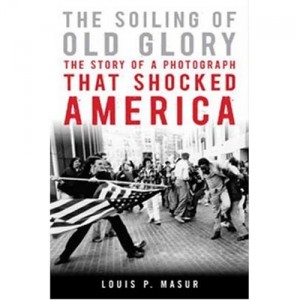 At Collectors’ Quest I just reviewed Louis P. Masur’s The Soiling of Old Glory: The Story of a Photograph That Shocked America — a book I can’t recommend highly enough.
At Collectors’ Quest I just reviewed Louis P. Masur’s The Soiling of Old Glory: The Story of a Photograph That Shocked America — a book I can’t recommend highly enough.
While the book is based on a very famous photograph, the Pulitzer Prize–winning photograph by Stanley Forman, taken on April 5, 1976 at a Boston rally against forced school busing, I’d never heard of or seen the photo before.
I don’t know why.
I was 12 years old at that time and I remember vividly Watergate, Viet Nam, etc.; so I obviously absorbed news. And I’ve always been interested in, sensitive to, and emotional regarding matters of race — something I’ve since put down not only to a combination of being human, being female (and so recognizing oppression), and “white guilt,” but as spiritual residue from being born on June 21, 1964, the date of James Chaney, Andrew Goodman, and Michael Schwerner were murdered (something I never knew until I was about 25 and rented Mississippi Burning). Plus, I’ve been a very avid student of history. So just how the incident & photograph escaped my knowledge is a mystery to me…
But once I found Masur’s book, my ignorance left.
And not just my ignorance regarding this (and other) incidents of relatively recent racism in this country (and in “the liberal north” yet!), but about photography, art, symbolism… And this country’s flag.
I had no idea that someone from my home-state of Wisconsin was so influential in the creation of National Flag Day, or that the Milwaukee Daughters of the American Revolution played a role in early anti flag desecration legislation. In fact, I had no idea that there was such concern over flag desecration as early as the late 1800’s. But what really rocked my cynical world was the reasoning behind it. Masur wrote (pages 98-99):
Even as the flag came to be venerated in the late nineteenth and early twentieth centuries, it became subject to another kind of treatment: desecration. Of course, it makes perfect sense that the two might emerge side by side, an object worshipped and reviled, an icon and a target. Reports and pamphlets in support of legislation against federal flag desecration began to appear, primarily in response not to overt acts of destruction but to the commercial use of the image of the flag. Arguing that “old glory is too sacred a symbol to be misused by any party, creed, or faction,” one writer included a list of objects on which “old glory… is treated with grave disrespect or used for mercenary purposes.” The items ranged from pocket handkerchiefs and doormats to lemon wrappers and whiskey bottles. In 1890, the House Judiciary Committee recommended passage of a law that made it a misdemeanor to “use the national flag, either by printing, painting, or affixing said flag, or otherwise attaching to the same any advertisement for public display, or private gain.”
What strikes me so odd — not that it should, I suppose — is that folks were so upset by the commercialization of the U.S. flag.
What on earth would they think of today’s patriotism? Of our current state of ridicule of anyone not wearing or displaying, on person or product, an American flag?
That sound you hear is the thud of fainting conservatives from the late nineteenth and early twentieth centuries. Or maybe it is the screams of horror from the same.
Once I wrapped my mind around such societal flip-flop, I then was left to revisit my own memories of the flag. A flag I’d seen on so many things… And that was before 9/11.
Heck, walk down any major isle at oh-holy-Wal*Mart this week, and try not to find something with the U.S. flag printed on it — tank tops with the flag & little white puppies, disposable plates with flags on them, socks with flags & fireworks, seat cushions… Endless. And all made to be profited from.
Was the Bicentennial responsible for this?
Back then (and I don’t mean just 1976, but the years surrounding it too) we had our school pictures taken with flag backgrounds, ate off flag forks, plastered cafeterias with flag-printed crepe paper & balloons, even applied flag printed toilet paper to clean our dirty butts. It was as bad as Masur notes, and, as he quotes, by then at least one member of the Sons of the American Revolution was OK with such kitsch: “I see no harm in these Bicentennial products. There is no harm in making a buck.”
But while the Bicentennial was the height of flag kitsch, I had some memories of flag use and “abuse” before then…
Again from Masur (page 107):
The meaning of America and the meaning of the flag went together. As the counterculture of the late 1950s and the 1960s came into prominence, attempts to redefine America often meant desacralizing the flag by wearing it. The cultural rebellion of the 1960s necessarily implicated the flag. [Allen] Ginsberg came to sport a top hat with the American flag motif. In discussing Ken Kesey, the Merry Pranksters, and the drug culture of the 1960s, Ginsberg argued that “they didn’t reject the American flag but instead washed it and took it back from the neoconservatives and right wingers and war hawks who were wrapping themselves in the flag, so Kesey painted the flag on his sneakers and had a little flag in his teeth filling.”
This was as I recalled from my television set. The protest film footage, the body paint on Goldie Hawn & Judy Carne on Laugh-In (and if the girls hadn’t actually worn flags painted on their bodies, well, I said it was as I recalled it…) It may not all have been as commercial as the Bicentennial kitsch was; but it was there, making it’s own statement, whether you dug it or not.
In the end, I agree with Supreme Court Justice Robert H. Jackson who, ruling on West Virginia State Board of Education v. Barnette in 1943, said:
To believe that patriotism will not flourish if patriotic ceremonies are voluntary and spontaneous instead of a compulsory routine is to make an unflattering estimate of the appeal of our institutions to free minds. We can have intellectual individualism and the rich cultural diversities that we owe to exceptional minds only at the price of occasional eccentricity and abnormal attitudes. When they are so harmless to others or to the state as those we deal with here, the price is not too great. But freedom to differ is not limited to things that do not matter much. That would be a mere shadow of freedom. The test of its substance is the right to differ as to things that touch the heart of the existing order.”
I don’t for a moment consider the use of the flag as a weapon to be anything other than criminal; that’s not my intent in any way. While the photo and exploration of the cult of flag connect in Masur’s book (they have to; the flag as symbol must be discussed), that’s not his point either. But what you have to see is a time, not long ago, when many felt the flag, like the country, didn’t represent them any more.
Here Masur repeats a quote Kenneth Clark published in Dark Ghetto:
The flag here in America is for the white man. The blue is for justice; the fifty white stars you see in the blue are for the fifty white states; and the white you see in it is the White House. It represents white folks. The red in it is the white man’s blood — he doesn’t even respect your blood, that’s why he will lynch you, hang you, barbecue you, and fry you.
There are many times I feel that way. Not just in theory. Not just as continuing amateur historian. But as a woman living her life here as a second class citizen. Without equal pay. Without the same recourse & credibility when she stands to seek justice. Without recognized rights to her own body. And with far greater (& societal accepted) risk of violence & sexual assault.
Why isn’t my gender’s blood part of the red on the flag?
I feel a reclamation-of-the-flag art project coming on.
Happy Fourth of July.
Police Woman: The Long Octopus Arms Twarting Female Police Detectives
 Most of us tend to think of Angie Dickinson when we think of police women — and it’s not just because she was Sgt. Suzanne “Pepper” Anderson on Police Woman in 1974.
Most of us tend to think of Angie Dickinson when we think of police women — and it’s not just because she was Sgt. Suzanne “Pepper” Anderson on Police Woman in 1974.
Most of us tend to think of the 60’s & 70’s when those women’s libbers pushed and sued for the opportunity to be equals (including police officers) and Angie baby was in full mod swing then, so naturally we “see” her as the face (and bod) of the mod we’ve-come-a-long-way-baby policewoman. And the plethora of Police Woman dolls & toys — like this ridiculous “Sabotage Under The Sea” set with octopus — helped solidify this image for a lot of us.
But in truth, there not only were female cops before then, but they were the result of what we’d now call “unlikely feminists” — and some bad male behavior. These battles would be more dangerous than tangling with an octopus.
You may have heard of Isabella Goodwin, the first US woman detective appointed in New York City on March 1, 1912 (it’s the sort of “fun historical fact” people like to blog about, say, on March 1st). But few take the time to give you some real information about her — or at least some cultural context. But you know I’m all about the context, right?
There’s little information available on the web about Isabella Goodwin (save for the fact one-liner), but there is a story & a setting alright.
The story begins in the mid 1800’s when female prisoners were housed with male prisoners and so male officers, their wives, widows of policemen (called “bedmakers,” these women were paid out of the policemen’s own pockets), or “the maid at the police station” performed searches on female prisoners. Such mingling of the sexes shocked the general public — mainly because of the high number of poor men and women who came to New York City often found themselves forced to find shelter at station houses (these people were called “casuals”). According to the NYPD, “in 1887, at various times, up to 42,000 of these homeless women spent at least one night in a station house.” However, things were about to change.
The Women’s Prison Association of New York and the American Female Christian Temperance Union petitioned the Board of Estimate and Apportionment for the appointment of police matrons, and for the creation of separate prison cells for men and women. If it sounds odd to you that Christian women of the 1800’s would be involved in a feminist push for equal career opportunities, you misunderstand. The push was not for careers for women, but for the protection of women who could be victimized by men. And you must remember that once upon a time, Christians saw their role in society as to help the less fortunate, including through social reform, as opposed to the current day philosophy of “”convert them or judge them & leave them to rot.”
Pressured by groups seeking social reforms, the New York State Legislature passed a law requiring that female doctors treat female patients in mental institutions & that every precinct station house has Police Matrons to tend to female arrestees. This legislation was passed in 1888. But the New York City Board of Police Commissioners does not make any Matron appointments until 1891 — after Governor David B. Hill signed a bill that mandated the hiring of Police Matrons and the establishment of separate cells for men and women under arrest. This was a direct result of a police officer being found guilty the attempted assault of a fifteen-year-old girl at a station house and sentenced to prison in 1890.
Months later, the first civil service test was held for the title of Police Matron — with applicants being required to have letters of recommendation from at least twenty women “of good standing.”
In an attempt at humor, I suppose, Jay Maeder sums up the “new” police matrons with “thus creating the jail-matron system that remained a sinecure for many a stern, stout Irishwoman well into the 20th century.”
:sigh:
Maeder’s stereotype isn’t the worst, or even the first. Gilder Lehrman Institute of American History notes:
Of course the matrons were not installed without criticism, which by the way ranged from the prediction that women would become totally incapacitated at the sighting of a mere rodent to criticism that men wouldn’t stand a chance because women would completely take over, dominating the station house and their fellow male employees.
Police Matrons worked long hours, receiving only one day off per month, and just one week’s vacation per year. In 1896, there is one Matron per shift (one day, one night) per station house. Their duties increase too. Matrons are now assigned to search subjects; process, escort and supervise inmates; and to care for lost children. As of 1899, they were paid $1,000 per year as of 1899, and they would not receive a pay increase until 1918.
It is in 1896 that police widow Isabella Goodwin (noted as having four children) is hired as a Police Matron and begins her police career, which will culminate in making First Grade Detective in March of 1912, and being appointed second in command of the first Women’s Police Precinct in April that same year.
Goodwin’s appointment to detective came about through the Police Chief bypassing Civil Service requirements that discriminated against women — presumably in large part due to pressure from the public and lots of press regarding her role in “bringing to justice of the taxicab bandits,” as evidenced in Goodwin’s interview in The New York Times, March 3, 1912 (below).
You really should read it; where else can you read a real news story which includes characters called Swede Annie and Eddie The Boob?
The old newspaper article also includes Goodwin’s story of a bust of a (male) fortune teller. The problem of $2 readings were apparently quite prevalent, for The New York Supplement details of Goodwin’s testimony & the judge’s affirmation of the conviction of fake fortune teller Maude Malcolm on Janurary 18, 1915 (beginning on page 919).
Goodwin, naturally, ends the interview with a, “Despite my peculiar work I try not to neglect my home. A woman’s first duty is to her family, and I have tried always to remember that.” To which the author is only too happy to pander, prove (with assertions from Isabella’s children & the author’s own eyes) & compliment.
But if this seems, well, less satisfactory than the loud “long way baby” route of the mod 60’s women’s lib ladies, consider the following…
Such public adoration may have been new to Goodwin and to female policewomen at the time, but Jay Maeder notes it wouldn’t stay that way:
Matrons did women pretty much exclusively until 1912, when one Isabella Goodwin, theretofore detailed to the wayward-lass wing of the Mercer St. station, was assigned to take a position as a domestic in a household full of suspected bank robbers. Goodwin, swiftly getting the goods on this bunch, then became New York’s first female detective first grade. Subsequently, more and more women began to get pulled into crime-busting duties, and a full-fledged Bureau of Policewomen was established in 1926.
The city’s lady cops, many of them nurses and lawyers and social workers and other such college-educated professionals, were celebrated public figures all through the 1930s and ’40s and ’50s, always good press copy as they went often quite dangerously undercover to lure sexual predators and smash abortion rings and whatnot.
Isabella Goodwin may never have had a doll or octopus made in her honor; but then again, she was probably never called “a bitch of a detective” in some sort of twisted praise. Angie Dickinson, on the other hand, only played a detective on TV and got the doll, the octopus, the pinup poses in men’s magazines, and had her then-husband, Burt Bacharach, “compliment” her by saying, “”If she’s down a notch from me in the public eye these days, well, she should be up a notch—she’s a bitch of an actress.”
So I ask you, who was the more respected woman? Who should we think of when we think of “police woman?”
And why hasn’t someone made a collectible Isabella Goodwin doll?
Maybe instead of an octopus accessory, it can have a fake fortune teller accessory kit.
How To Make Yourself A Black-Faced Negro
From Max Factor’s Hints On The Art Of Make-Up, Booklet No 5: Popular Stage Types (23rd edition, copyright 1961), instructions for “black-face comedians” to become The Negro. Part of my vintage boxed Max Factor “Male Stage Make-up Kit” for students set.
Now It’s Really The Last Laugh
As usual, a tiny snippet in a vintage magazine drives me to obsessive research…
This time it’s a few lines on page 47 of Quick (November 21, 1949 — which had that feature on Esther Williams). The few lines, titled Last Laugh, are about the widowed singer, Mrs. Reseda Corrigan, who after having fallen prey to infamous bigamist Sigmund Engel, announced her plans for both a vaudeville act “showing how Engel made love to her” and her engagement to “booking agent and bandsman,” Al Turk.
Apparently it is worth noting that Mrs. Corrigan was not only a window, mother of three, and a singer, but a redhead — and her fashions were greatly detailed in the press reports of the court trials. I love how women’s fashions pertain to courtroom drama. Not.
Sigmund Z. Engel, was a real charmer. He’s credited with saying, “The age of a woman doesn’t mean a thing. The best tunes are played on the oldest fiddles.” And he apparently offered the press advice upon entering prison:
1. Always look for the widows. Less complications.
2. Establish your own background as one of wealth and culture.
3. Make friends with the entire family.
4. Send a woman frequent bouquets. Roses, never orchids.
5. Don’t ask for money. Make her suggest lending it to you.
6. Be attentive at all times.
7. Be gentle and ardent.
8. Always be a perfect gentleman. Subordinate sex.
Engel also wrote a book, titled Lover of 1001 Women — a copy of which currently eludes me. But I have heart. I always have heart when it comes to collecting; but love can be far trickier… As Mrs. Corrigan herself warned in the St. Petersburg Times, June 23, 1949, “When a man uses excellent English, whispers ‘I love you’ while at the same time kissing your ear, beware.”
It’s important to note that Mrs. Corrigan was not just bigamist-bitter, nor even money-taking-bigamis-bitter, but royally-pissed-bitter. This because during Engel & Corrigan’s engagement Engel went missing for a week. Then he suddenly called and asked Corrigan to take the first train out of Chicago and meet him in New York’s Grand Central Station. Corrigan complied. Not only was Engel a no-show, but, because Engel was supposedly wealthy, she arrived without any money of her own and was forced to live in Grand Central Station for eight days — sleeping in the washrooms and on public benches.
That would leave a bitter aftertaste all its own, yes? This is when she filed charges in Chicago, resulting in Engle’s photograph being published & the ensuing suits.
So we can understand Corrigan’s boasting in the press about her show and upcoming nuptials.
But Corrigan wasn’t to have the last laugh as far as I can see.
In the St. Petersburg Times, November 20, 1949, the following bad news:
Mrs. Reseda Corrigan’s “kissless romance” with band leader Al Turn is one the rocks — right where the vocalist was left by Sigmund (Sad Sam) Engel when he dashed off with her $8,700.
Soon after Engel’s conviction in Chicago, Mrs. Corrigan, 39, disclosed plans to marry Turk. But Turk said yesterday the whole thing was washed up. He explained: “She does a fair job of singing but she needs a log of training.”
Mrs. Corrigan was caught off base by Turk’s announcement but fired back: “I have more finesse than he has. He has no gallantry about him. Why, he didn’t even kiss me.”
Neither did Engel, she insisted, because “I’m a singer and I don’t want to be going around with germs in my throat.”
I’ve got a little something in my throat… I think it’s bile.
If anyone knows anything more about Reseda Corrigan, I’d love to hear about it — especially if you have a photo!
History Is Ephemeral Carnival, 2nd Edition
 Welcome to the second edition of the History Is Ephemeral Carnival, where “old paper” is more than just an obsession or a fire hazard — it’s the stuff of discovery.
Welcome to the second edition of the History Is Ephemeral Carnival, where “old paper” is more than just an obsession or a fire hazard — it’s the stuff of discovery.
Azrael Brown presents The Big Book of Cattle Brands posted at Double-Breasted Dust-Jacket.
Tattered & Lost presents When bluebirds fly over 4 leaf clover YOU’LL FIND A PIANO SALESMAN posted at Tattered and Lost Ephemera.
Frank presents Rare laser & holography art exhibit posters from the 80’s posted at HoloWorld at YouTube.
J.W. presents Victorian Beauties posted at The Collective Picture, saying, “A blog that collects photos and talks about their significance. This post is about the history of photography, and show’s early images of Victorian woman.”
Cliff Aliperti presents The Sporting News Coverage of Lou Gehrig Surpassing Everett Scott’s Record posted at VintageMeld.com.
I present When Does It Become Too Hot To Operate A Model Railroad? (Or, Taking A Ride On A Model Train To Meet The Emperor of Death Valley) posted here at Kitsch Slapped.
Azrael Brown presents Helen and Mrs. Faucher in blackface posted at The Infomercantile.
J.W. presents Tobacco Floats, Prize Goats and Billy Bowlegs posted at The Collective Picture.
Tattered & Lost presents Where have all the FLORIST SHOPS GONE? posted at Tattered and Lost Photographs.
Love old paper? Found something interesting? Please, submit your blog post/article — or one you like — to the next edition of history is ephemeral using the carnival submission form.
Past posts and future hosts can be found on the blog carnival index page. (If you’d like to host, just let me know!)
Technorati tags: history is ephemeral, blog carnival.
When Does It Become Too Hot To Operate A Model Railroad? (Or, Taking A Ride On A Model Train To Meet The Emperor of Death Valley)
When does it become too hot to operate a model railroad?
When the thermometer reaches 160 degrees.
So said T.R. Goodwin, superintendent of Death Valley National Monument — and model railroad enthusiast — in that oh-so priceless March 1951 issue of Profitable Hobbies Magazine. (Click to read the large scan.)
But the story doesn’t end there. Well, it probably does for most people; but I’m one of those obsessives, remember? I find one (admittedly amusing) article, and I have to find out more.
(Here’s where I recommend you have a beverage & settle in to read. This 1950’s article about a man and his model train set is better than Mister Rogers’ trolley taking you to the Neighborhood of Make-Believe; Goodwin’s train, said to be the only train for 145 miles — and probably long neglected by now if parts of it even exist — takes you back in time.)
While the heat standard for model railroad use set by Goodwin in 1951 should speak for itself, the official hottest temperature recorded for Death Valley is listed as 134° (in July, 1913, at what is now Furnace Creek Ranch). But, that really doesn’t matter much to me; frankly, when the temp reaches 125, most all of my hobbies would cease — as would my breathing, probably. Anyway, I was now left to research T. R. Goodwin himself.
The short article in Profitable Hobbies Magazine says that “Mr. Goodwin opened Death Valley as a national monument under the jurisdiction of the National Park Service in 1933. Since that time he has watched his barren domain grow rapidly in importance as a tourist attraction.” So I thought there would be a rather large amount of information on Goodwin. But I was wrong.
It’s disappointing to find so little on Goodwin; not just because I’m obsessive, but because from what I can piece together, the man plays important roles in US history. And why shouldn’t he? As Superintendent of The Death Valley National Monument, T.R. Goodwin, was called “Emperor of Death Valley” in Harry Oliver‘s Desert Rat Scrap Book (Packet Three, Pouch Four, 1950, page 3, “The Mail Pouch”), saying, “Though his majesty rules an area larger than some of our states with considerable more power than any Governor, it is whispered that his highness has to swat his own Vinegarones and take his own pet tortoise out for a run.”
Homey & humorous, yes; full of yesteryear’s non-pc protocol, sure. But knowing that Goodwin was in charge of nearly two million acres, you have to consider the truth of it too.
While the discovery of the Desert Rat Scrap Books (which are full of charming & inappropriate old stories — including many attributed to Goodwin) would be a delightful enough conclusion (or, more accurately, a lovely collection pursuit), there is far more. If you are willing to devote hours, days to researching Goodwin. And I am. (Need to replenish your beverage yet?)
At first the info is sketchy. The “T.R.” in T.R. Goodwin stands for Theodore Raymond Goodwin. He served in the Spanish-American War, lost his first wife after just a few years of marriage, and RootsWeb says that T.R. Goodwin was the brother of noted western artist Philip R. Goodwin.
There’s a Death Valley ’49ers “Keepsake” booklet on T.R. Goodwin, published in 1978 — but apparently long out of print. (I’ve ordered a copy & will share what I can.)
Until I get the book, this is what I’ve been able to piece together.
While Goodwin may have been the first official superintendent, his gig didn’t start until 1938, according to the National Park Service. Officially, the Death Valley National Monument was established by President Herbert Hoover on February 11, 1933 and John R. White was the acting superintendent, starting on March 16, 1933, until April 14, 1938; then Goodwin took over on April 15th as the official superintendent.
According to NPS administrative history information, Goodwin seems to have appeared on the government parks scene sometime prior to 1928, when he was the director or roadwork done in the Cold Spring, Anna Spring Plaza, Anna Spring Dam, and the Rim Village area.
Three park roads received surfacing/oil processing treatment in 1928 under the direction of T.R. Goodwin, a road oiling expert loaned to the National Park Service by the California State Highway Commission.
Goodwin must have loved the area & the people, because before he was established as superintendent Goodwin wrote an article (“Park Ranger Believes Early White History Lies Behind Sealed Lips of Red Man Of The Desert,” Inyo Independent, 29 October 1937) on the Indians of the region, “and in so doing attempted to delineate some of the relationships.” He & his writings on Native Americans was written about as well. Perhaps care & concern for the people and land is what got him the superintendent gig rather than his construction skills — or willingness to put up with the heat of Death Valley.
Among the John P. Harrington papers (from 1907 – 1959) held at the Smithsonian Institution, are letters between Harrington, the American linguist and ethnologist who specialized in the native peoples of California, and Goodwin. These letters, dated May of 1946, show Harrington preparing for a field visit to study the Death Valley Indians.
JPH to Goodwin, May 11, 1946:
The writer is Ethnologist in the Bureau of American Ethnology, Smithsonian Institution, and wants to make a study of the Death Valley Indians. I understand that the Indian Village in Death Valley is 30 miles from your Park Headquarters – in which direction and how reached? Is this village at Death Valley Junction? Any information that you give me will be greatly appreciated. It may be that it is too late in the season to visit this Village for I am told that the Indians of it repair to remote places in the mountains during the summer months. I could come in the fall. There must be some Indian who would be a good interpreter or informant – what is the name of such a one, or better the names of several. They say that only the northern part of the Panamint Mountains belonged to the Death Valley Indians, that is, to the Shoshoni Indians, and that the southern part of the Panamint Mountains belonged to the Chemehuevi Indians. That would make it that there are two languages spoken at the Village. Or has the Chemehuevi language retreated – to where? Where was the line? Or was it the Serrano language of the Tehachapi Mountains instead of the Chemehuevi language? Who were the Panamint Indians – did they talk Chemehuevi? Who were the Pitant Indians? Who were the Keits Indians?
Goodwin to JPH, May 15, 1946:
With reference to your letter of May 1[1], 1946…
Most, if not all, the Indians move to the high country in the summer returning after gathering pinon nuts in the early fall. Practically all the males speak good english and one in particular Tom Wilson who is half breed Piute with a Mexican father, is married to the daughter of the former Chief Hungry Bill. Tom is intelligent and speaks excellent english.
I have never heard of any territorial division of the Death Valley Indians. They are supposed to be an off-shoot of the Shoshone tribe. . . . The Death Valley Indians are called Panamint Indians and all live here except for a few around Beatty, Nevada and one family in the Panamint Valley. They are not wards but are under general supervision of the Carson Agency at Stewart, Nevada. All the other Indians I know of surrounding the area are Piutes and said to be tribal enemies of the Panamints.
JPH to Goodwin, May 20, 1946:
Your extraordinarily kind letter, full of information, has arrived and I am surely glad that I wrote you before coming. Several of the matters that you state perplex me.
A Chemehuevi (Piute) Indian told me that the Panamint Indians speak the Piute language; that the northern part of the Panamint Range was held by another kind of Indians, an off-variety of the Shoshones, whom a Panamint Indian can not understand; that way north of these quasi-Shoshones there lives another kind of Piutes known as the Northern Piutes, who speak another non-intelligible language — that same one that is spoken by the Bannock Indians, in southern Oregon, at Carson City, Nev., at Bishop, Calif., etc.
Thanks a million times over for telling me about Mr. Tom Wilson – is he still at Furnace Creek? How could I write to him? He would perhaps instantly know about this Shoshone-Panamint mix-up. Isn’t there any place that one could board at Furnace Creek though the Inn is closed? It may be going to require Indians to straighten this matter out. . . .
Goodwin to JPH, May 27, 1946:
Replying to your letter of May 20, 1946, you apparently have certain information that has never been brought out here, although we have had close touch with the Indians in this vicinity over a period of thirteen years. . . .
While there’s a certain level of condescension in referring to a “half breed” as “intelligent,” one must remember that in 1946 “Injuns” had it far worse. It was a different time & place, and Goodwin was living in The West, among such characters as Walter Scott aka Death Valley Scotty, one of the rough-riders for the Buffalo Bill Wild West Show turned prospectors who built Scotty’s Castle.
Tribute to Goodwin’s own intelligence can be found in history books: He is called “a more sympathetic Park Service official” in Forgotten Tribes: Unrecognized Indians and the Federal Acknowledgment Process by author Mark Edwin Miller, and in Death Valley (Images of America: California), author Robert P. Palazzo says Goodwin was “instrumental in taking up the cause of the Timbisha to prevent their removal from the monument.”
In the correspondence between Goodwin & Harrington, I am particularly amused by the polite perplexed assertions each professional makes as they defend their information about the Timbisha Shoshone people; especially how Goodwin, a former road oiling man turned government administrator, holds his own against Harrington, the bookish linguist and ethnologist.
Gawd – I love old letters like this.
But Goodwin’s story doesn’t end here either.
During World War II Japanese-Americans had it as bad as Native Americans. Not just racist Asian humor, but in removal from their homes. Ten camps on US soil imprisoned over 110,000 Japanese American citizens and resident Japanese aliens during WWII — one of which was Manzanar. A place already with a long history of forced relocated peoples. (I swear my history books & lectures never really imparted this knowledge to me; nor had I ever grasped the concurrent plight of Japanese Americans & Native Americans. And, if that doesn’t blow your mind, consider that Ansel Adams was at Manzanar taking photographs.)
In December 1942, a riot broke out at Manzanar War Relocation Camp. This became known as The Manzanar “Incident.”
On December 6, 1942, one of the most serious civil disturbances to occur at all the relocation centers erupted at Manzanar. Months of internal tension and gang activity had raged between members of the Japanese American Citizens League (JACL) and many of the first-generation Japanese. Although the JACL leaders acted as representatives to the administration, the elders did not share their views and had little respect for them. Meetings turned into shouting sessions with beatings and death threats against the pro-administration group.
On the night of December 5, six masked men beat JACL leader Fred Tayama while he was in his bed. The leader of the Kitchen Workers Union, Harry Ueno, was arrested for the beating and jailed in the nearby town of Independence despite a lack of conclusive evidence. The next day about 2,000 internees gathered in support of Ueno, and a “committee of five” was selected to negotiate his release. Center Director Ralph Merritt attempted to talk with the agitated crowd and subsequently agreed to bring Ueno back to the relocation center jail to avoid further violence or bloodshed.
…By evening, the soldiers who were stationed in front of the building drew a line in the sand but the hostile protesters surged closer. The crowd became extremely unruly and tear gas was used to break up the demonstration. Although no orders were given to shoot, soldiers fired into the crowd, and a 17- year old was killed and eleven others were wounded. One of the wounded died later on December 11.
Protesters who were considered troublemakers were removed from the camp and held in local jails. Those who were U.S. citizens went to a WRA isolation center at Moab and non-U.S. citizens were sent to Department of Justice camps. Most work, except oil delivery and kitchen crews, was suspended by the administration until after Christmas. By early January 1943, the camp’s operations fully resumed, and schools reopened on January 10.
But what of Tayama & others who were attacked and threatened? Here’s more of the story of Manzanar:
On Sunday night and Monday, December 6 and 7, threats were made against many evacuees at Manzanar who were outspoken pro-American advocates or who were perceived to have pro-WRA administration sentiments. Those threatened included staff members of the Manzanar Free Press, members of the internal security police force, and evacuees who had supervisory jobs in the center. Many of these evacuees, including Tayama, Tanaka, and Slocum, had been active members of the Japanese American Citizens League prior to evacuation, and many had encouraged evacuee cooperation with the government’s relocation policies. John Sinoda, a 25-year-old Kibei who held a key position in the camp’s employment office, was severely beaten by a gang with clubs at the outdoor theater, receiving scalp lacerations. Others were assaulted, including George Kurata, the camp housing coordinator, who managed to escape from his attackers. [49] By Monday noon, approximately 40 evacuees had entered the camp Administration Building, asking for protection and indicating that they were afraid to remain in their barracks. The administration also aided removal from the barracks those evacuees whose names appeared on the dissidents’ blacklists and deathlists. Thus, the number of evacuees taken into protective custody by the camp administration subsequently increased to 65 individuals.
The evacuees in protective custody slept on cots in the Administration Building at night and were crowded into a room in one of the military barracks in the military police compound south of the camp during the day. There was insufficient room for all of them, however, and they were forced to take turns “in getting warm.” They were fed in the kitchen in the military police compound. [50]
Faced with the dilemma of protecting the 65 people, Merritt and his staff immediately began a search for a place outside of Manzanar to house them on a temporary basis. Merritt and Brown had been associated with T. R. Goodwin, Superintendent of Death Valley National Monument, during their days with the Inyo-Mono Associates as well as the Citizens Committee established by the military to ease public relations for the camp with the Owens Valley residents following evacuation. Thus, Merritt sent Brown to Death Valley to inquire as to whether the national monument had any place to house the people. Goodwin offered the abandoned Cow Creek Civilian Conservation Camp, comprised of 16 deteriorating buildings adjacent to the monument’s headquarters. After considerable discussion and clearance was received from WRA Director Myer and General DeWitt, the 65 evacuees, who became known as “refugees,” were sent to Cow Creek on December 10.
…The Cow Creek camp was administered by Camp Director Albert Chamberlain, a WRA employee, and Fred Tayama was elected unofficial “mayor” by the refugees. The WRA staff, evacuees, and soldiers shared the same latrines and showers and ate at the same times in the mess hall which was supplied from Manzanar. After improving their quarters and the grounds of the camp, the evacuee men, needing something to do with their time and appreciative of the hospitality shown by the National Park Service, painted signs, cleaned out springs, built dams, dug ditches, mixed cement, installed radio antennas, and conducted other odd jobs in the national monument without pay. The evacuee women spent their days, caring for their children, assisting in the mess hall, and housekeeping. During their stay. Park Service personnel, as well as the soldiers, took groups of evacuees sightseeing in the national monument and on trips to pick up supplies and mail. The camp had a swimming pool that was enjoyed by the older children. The 65 evacuees remained at the Cow Creek camp under military guard, primarily for their protection, until arrangements could be made for their release through indefinite leave and assistance could be provided for relocation. The American Friends Service Committee played a major role in obtaining jobs and homes for the evacuees, sending representatives to Cow Creek to interview and assist them in planning for relocation. As a result of this organization’s efforts, many of the evacuees relocated to Chicago where the Friends had established a hostel to help those relocating from the relocation centers. As jobs and housing became available, departing evacuees were taken to Las Vegas, the nearest railhead, via military escort. By mid-February the “refugee” camp at Cow Creek was vacated. [51]
I wonder if any of the group of 65 Japanese and Japanese American internees brought into Death Valley for their safety got to see or play with Goodwin’s model railroad?
Is this the end of Goodwin’s story?
It is unclear. For while little else could be found about him, it seems unlikely that such an active man would just wither away, content to be a relic of the past. He must have been more than just a fascinating old coot, with lots of stories to share (should anyone be willing). But for now, I have nothing but blanks.
T. R. Goodwin died in 1972; this I learned from his wife Neva’s obituary, which also lists Mr. Goodwin as “an engineer in Sequoia” prior to placement as superintendent of the Death Valley National Monument. This may not be so accurate. Other research, again tied to Neva Goodwin’s death, states that T.R. Goodwin died in 1969:
T. R. “Ray” Goodwin preceded her in death Oct. 27, 1969. Research Note: Stone reads that he died Oct 25, 1969.
It’s interesting to note that while Mr. Goodwin was an amazing man — one I think ought to be remembered — that his wife’s obit mentions next to nothing of her own life. This sexist fact is noted by Cathy Spude in her discussion of Mrs. Goodwin’s obituary, as published in The Electric Courier, and electronic newsletter for the employees of the National Park Service:
September 11, 1996 Volume 2, Number 13
“Neva Goodwin, 100, died August 14 at the home of her daughter, Kay Hamblin, in Yreka, California. She was buried in Monett, Missouri. Mrs. Goodwin was the first superintendent’s wife to live in Death Valley. T.R. Goodwin had been an engineer in Sequoia when he was put in charge of the newly created monument in 1933. He also served in Yellowstone, Yosemite and Grand Canyon during his NPS career. He died in 1972. Memorial donations in Mrs. Goodwin’s name may be made to Waldensen Presbyterian Church in Monett, MO 65708. Survivors include sister Chris Driskill, daughter Kay Hamblin, son Ted Goodwin, five grandchildren and one great-grandchild. Contacts with the family may be made through the Death Valley public affairs office.”
So we see that gender-based stereotypes in obituaries is not confined to the late 19th and early 20th centuries; it is here in 1996! It appears, from this obituary, that Neva Goodwin’s primary contribution to society was through her roles as wife, sister and mother. More information was given about what her husband did in his career than about Neva in her career as wife and mother.
The editor of this newsletter would probably be defensive if I suggested that his obituary was androcentric; he would no doubt reply that the readers of the newsletter are more interested in fellow employees (i.e., the deceased’s husband) than in their spouses. I wonder how many people in the service do indeed remember a man who died in 1972 (my 21-year career post-dates that event). Neva without a doubt continued to contribute to something at Death Valley, that the public affairs office is handling contacts with the family. What that contribution was, we cannot tell from this obit.
Surely as his wife, living with him in Death Valley, Neva Goodwin had her own work — and stories as well. She must have raised their son (the very one, according to the original 1951 article, the first of T.R.’s toy trains was purchased for). And, I imagine, Neva spend many a night trying to get Superintendent Goodwin to stop playing with his toy trains long enough to get something to eat & sleep before he began he’d have to get up in the morning and become Emperor of Death Valley again.
New Vintage Reviews Carnival, Second Edition
 Welcome to the second edition of the New Vintage Reviews Carnival, where we review “old stuff” that is likely new to someone… In the hopes that it inspires you to dust off the things in the closet, basement, attic etc. and put them to use. (Maybe even head to the thrift store rather than the mall?)
Welcome to the second edition of the New Vintage Reviews Carnival, where we review “old stuff” that is likely new to someone… In the hopes that it inspires you to dust off the things in the closet, basement, attic etc. and put them to use. (Maybe even head to the thrift store rather than the mall?)
Reuse, recycle — rejoice!
Books & Reading:
The Dean presents Old Time Modern Priscilla posted at Collectors’ Quest.
Sarah Sammis presents Don Quixote: Sancho’s Big Score posted at Puss Reboots: A Book Review a Day, saying, “Don Quixote was my first series of reviews that use pop culture to review the book. I posted the final one in the series which has links to the previous posts.”
Azrael Brown presents Book vs Film: Immortality Inc / Freejack posted at The Double-Breasted Dust Jacket.
Films:
Jaynie presents The Knack (And How To Get It) In Romance & Fashion posted at Here’s Looking Like You, Kid.
I present Does Sparkle Shine? here at Kitsch-Slapped.
Games:
Collin presents Vintage Board Gaming : Mr. Know-It-All posted at Collectors’ Quest.
I present Bingo, Anyone? (a word of caution — and hope! — about old Bingo games) posted at Collectors’ Quest.
Audio:
Collin presents Tag Sale Finds : Sounds of Terror LP posted at Collectors’ Quest.
Collin presents Tag Sale Finds : Armand Schaubroeck Steals posted at Collectors’ Quest.
Things To Do & See:
Sheila Scarborough presents Classic kid movies in classic theaters – yay! posted at Family Travel Guide, saying, “Why the Austin, Texas Paramount Theater rocks my household with its annual summer Film Series of classic movies.”
NAOMI presents Laurel and Hardy Statue Unveiled in Ulverston posted at Diary From England.
Honorable Mentions:
Kyle Boyd-Robertson presents “The Rialto” or “If That Old Theater Could Talk” posted at his TEN blog — it’s a nostalgic post about old movie theaters (with plenty of comments & photos!) Maybe it will inspire you to visit &/or support your old downtown theatres this summer?
Sam presents Famous Baseball Players and Their Teams posted at Surfer Sam and Friends — it’s certainly interesting to note this time of year. (Maybe it will inspire kids to collect & learn as well as play!)
I present What A Collection Can Do: A Love Of Vintage Inspires Designer Of Hot Trendy Fashions posted at Collector’s Quest — to inspire you to take a look at “old clothes” as “a pile of fabric possibilities!”
This concludes this second edition. Please submit your blog articles to the next edition of new vintage reviews using the carnival submission form. Past posts and future hosts (maybe you’ll be one?!) can be found on our blog carnival index page.
Technorati tags: new vintage reviews, blog carnival.
The Postman Always Rings Twice — Unless He’s Delivering Swine Flu
Philip Alcabes was on The Daily Show recently promoting his book, Dread: How Fear and Fantasy have Fueled Epidemics from the Black Death to the Avian Flu, and talking about how our fears play a huge part in epidemics — like the recent return of the swine flu. So, with this on my mind, I find Frank DeFreitas’ post on historical hysteria over postal pieces as “carriers” of disease timely and fascinating:
Many letters in the past were opened for fumigation, then closed using sealing wax. The list of diseases that were singled out include plague, yellow fever, typhus fever, cholera and leprosy.
DeFreitas’ post contains many links to suit the most die-hard history detectives (obsessive nerds); I wonder if Alcabes’ book does — and if it even contains the story of disinfected mail?

